| |
Vietnam-Germany-Fort Irwin: the
Eaglehorse and the M551 Sheridan
From the rubber plantations and rice paddies of Vietnam to
icy tank trails at Grafenwoehr, to the red-yellow dust of
Fort Knox to Panama and Fort Bragg and dozens of National
Guard hardstands and then rapid deployment to Saudi Arabia
in support of Desert Shield to finally masquerading as
threat armor in the California deserts at Fort Irwin, for
the M551A1 Sheridan tank, it has indeed been a long and
strange ride. A thoroughly new concept in tank design, the
first models came to active service in Vietnam in 1969, the
last of the fleet will be phased out at Fort Irwin in early
2004. Three generations of US Army tanker-scouts served on
this vehicle.
Troopers of the Blackhorse Regiment and Eaglehorse Squadron
played an active role in many of the major chapters of the
story. They painted on the first bumper numbers in Vietnam
and will scrape off the unit designations at Irwin during
final turn-in. They lived with them, died with them,
struggled and cursed, kicked butt at the NTC and broke down
on the Autobahn. Most of the Sheridans could run all day,
many could fire the main gun and hit, the missile launch was
a big thrill at Level 1 gunnery for a lucky crew, SSG
Pharris and crew of Troop G, 2/11 ACR got to do it all.
We tell the story of the Sheridan at both the crew level and
as a fascinating insight into how the best intentions of
engineers, manufactures, politicians and career military men
can become part of a program going clearly wrong. Long after
the M551 had been largely withdrawn from active combat
units, the memories of the program had a lasting effect on
the design and procurement of future Army tanks. Much of
what was done right with bringing M1, M2 and M3 through the
design and manufacturing phase and then into the inventory
can be traced back to lessons learned from the Sherdian
program.
The Eaglehorse and the Sheridan is a long and complex story,
rich with detail; we have tried to craft the text in
manageable sections. The first three portions consider the
evolution of US armor vehicle design and procurement that
led to the decision to produce the M551, then Sheridan OST
at Fort Knox and combat experiences in Vietnam. The history,
design and development text is heavily sourced from R.P.
Hunnicutt's seminal work, Sheridan: A History of the
American Light Tank, Presido Press, LTC (Ret) Burton S.
Boudinot's article "A Sheridan Memoir: The Early Days",
Armor Magazine, Jan-Feb 1997, the article "Soldiers" by Ward
Just, Oct-Nov 1970 Atlantic Magazine and the archives of the
Cleveland Press and the New York Times. The Vietnam section
is built with recollections of Col (Ret) Clint Ancker, LTC
(Ret) Lee Allen, and major text and photo contributions from
Doug Kibbey and Roy Lingle. As the Sheridan story turns to
Germany and Bad Kissingen, Col (Ret) Norman Harms, and Terry
R. Smith provide details covering the fielding of the
vehicle to the 2/14 ACR. A mini photo album with scenes of
the fielding was contributed by the family of Gary Bell.
After the re-flag to the 2/11 ACR, Col (Ret) Anker, Col
(Ret) Chris Conrad, LTC (Ret) Lee Allen, Col Mike Heredia
and Bob Stefanowicz pick up the story. Continuing towards
the present, the M551 becomes a micro fleet of specialty
vehicles at Fort Bragg and Fort Irwin, Bobby Haig and Doug
Kibbey tell the story with great text and photo
contributions. In our summery, we briefly
reconsider the Sheridan program and examine the role of
memory and the last running M551.
Our photos come from a variety of sources, the Hunnicutt
work, 14th ACR unit yearbooks, TMs and donated images from
various troopers from Vietnam to Germany and the NTC. We are
always searching for additional images and hope that you
will consider helping us out.
For anyone wishing to study the story of US armor vehicle
development in the post war period, the works of Mr.
Hunnicutt are highly recommended. They are in print and can
be special ordered through many major book outlets.
| |
|
|
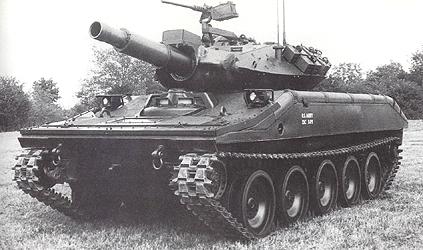 |
|
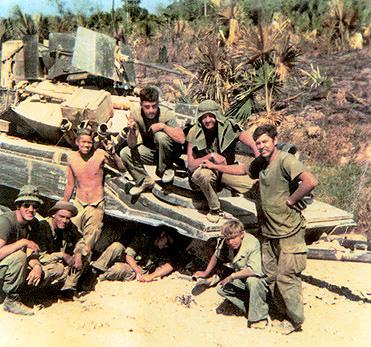 |
The M551 Sheridan, from just off
the assembly line at the Cleveland Tank Plant ...
--R.P. Hunnicutt |
|
... to Vietnam and service with
Troop F, 2/11 ACR ...
--Doc Balas |
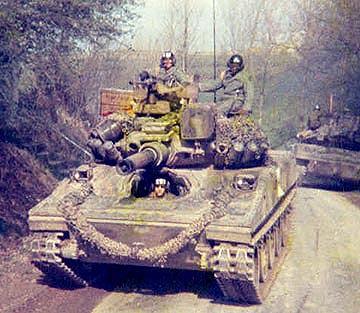 |
.. to the side roads and Autobahns of Germany a few
years later with Troop E ...
--Dave Thompson |
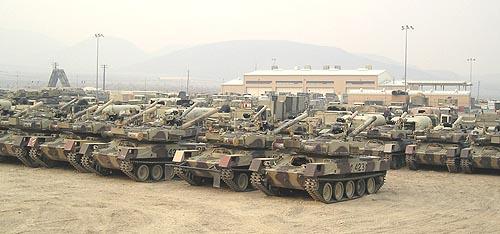 |
... to the National Training
Center, reunited with the squadron, this is the story of the General
and the
Eagle, the M551 and the Eaglehorse Armored Cavalry Squadron.
--Doug Kibbey |
Part 1: The Light Tank, a Valid Concept
Part 2: The Blank Sheet: "... but does it
float?"
Part 3: A Brave New Concept
Part 4: The Battle Joined: Vietnam, the Eaglehorse and the Sheridan
Part 5: Germany: the
M551 and 2/14 ACR
Part 6: Germany: the
M551 and the Eaglehorse
Part 7: The First to
the Fight
Part 8: The New Mission, Reunited with the Eaglehorse
Part 9: The M551 Sheridan Program Recalled
US armored vehicle evolution from the end of World War II to the
present day was a complicated process and to be too brief is to miss
the key detail that builds the story. On the one hand, there is a
seemingly straightforward progression from the M47 to the M48 to the
M60 and M60A1 series to the M60 A3 and finally an evolutionary jump
to the M1. There was always a parallel evolutionary path, heavy
tanks funded then canceled (M103), light tanks proven and abandoned
(M24 and M41), experiments and joint projects to "break the old
design molds" (MBT 70), projects that were disastrous (M60A2) and
production models based on the intersection of new design, new
weapons technology and new war fighting doctrine (M551). Viewed as a
whole, it is a fascinating story of how industry, politics, Generals
and Senators always vie, compete and compromise in the life cycle of
major combat system procurement. The troopers in the squadrons and
battalions held their collective breath and waited for the next ...
big .... thing.
Often, the argument in the 1950s and early 1960s came down to a
single question: were the needs of the Army best met with a single
medium tank or some combination of light, medium and heavy models?
From the middle of World War II through the early 1960s, generals,
politicians, designers and manufactures passionately argued the
issue.
For a few years, armor development was biased toward one faction,
then, like a pendulum, it would swing towards the counter argument.
Sometimes a compromise was made that pleased many and disappointed
most. World War II experiences fueled arguments for both sides. Had
not vast fleets of the medium and hardy M4 Sherman tank proven the
key ingredient to victory?? Had not the last years of the war proven
that the heavy German tanks, if mass produced, could only be
countered by a US heavy tank?? Wasn't the M24 light tank an ideal
companion to the infantry and scouts?? Hadn't too many different
tanks become a burden for trainers and logisticians?? They argued
back and forth.
The war in Korea only further complicated the issue. It was not good
tank country but there were some stiff fights. Chinese and North
Korean T34s swept through the M24 light tanks and were stopped by
the medium-heavy M26 US Pershings. The infantry however, argued that
the M24 or some improved model was necessary for the urban fighting
in Korean cities and towns. Clearly, the last of the M4 Shermans had
to go but what would the new armor force look like and as always,
the fear of war in Europe held everyone's attention. The Soviets
seemed to roll out new and potentially dangerous tanks at each May
Day parade.
In Bad Kissingen, the newly arrived reconnaissance squadron was an
early recipient of each new US tank as fielding went forward for 7th
Army units. Our contacts from the early 1950s clearly recall the
recon companies staffed with the M24 and the tank company with the
M26. 1952-1953 must have been a hectic year on the ranges and
training areas, both old systems disappear, replaced respectively by
the M41 and M47 tanks. Troopers recalled the M24 Chaffee as "light
but hardy, a good runner", but the M41 was a clearly superior
vehicle.
Carried forward by the momentum and funding of tank development from
WWII, the M41 light tank was ready for fielding too late for Korea
but certainly on time for Europe. It was intended to be the
companion "light" tank to the M26 and later M47 then M48
"medium-heavy" tanks in the inventory. The Cadillac Motor Car
Division of General Motors was the prime contractor and over 3700
units were produced at the Cleveland Tank Plant. The new tank
featured some of the innovations the Army had demanded, a fully
powered turret the primary step forward, the potential to experiment
with a semi automated loader and improved optic sights. The
engine-transmission-final drive layout became the platform that,
much modified, drove US tanks through the M60 series. As a
compromise, the Army agreed to accept the vehicle before all the
design requirements were met.
At about 26 tons combat weight and a crew of four, it was a success
with the troops. The initial 76 mm cannon was considered acceptable,
the fleet recycled back to the factory at least once during the
operational life with the Army for a series of improvements, the top
speed was listed as 45 mph. The problems of the auto loader were
never satisfactorily worked out and that modification never went
forward. For the infantry and cavalry units, the M41 was fast,
maneuverable and reliable although it consumed fuel at a frightening
rate. It seemed as though those who had argued for an armored force
mix calling for both light and medium tanks were correct.
As a testimony to this design, beyond the production runs to honor
US government contracts, the Cleveland Tank Plant produced several
thousand additional copies for foreign sales. The armor force of the
new West German Army, the Bundeswehr, was first built with M41s and
the South Vietnamese Army followed suite some years later. M41s to
this day, much modified and improved, can be found in service in
several foreign countries. This tank kept thousands of employees of
GM's Cleveland Defense Plant in steady work for over fifteen years.
The troopers held it in high regard.
| |
|
|
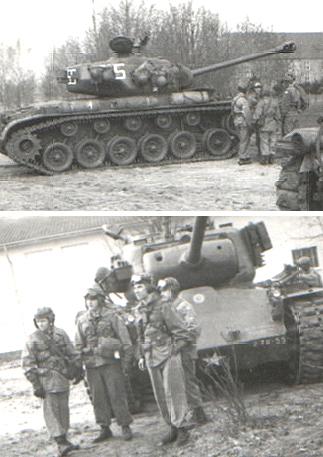 |
|
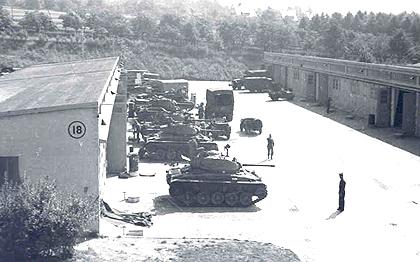 |
This is 1951, either just before or
after the move to Bad Kissingen. The tank company has the M26
Pershing tank. The guys have good uniform discipline in the field.
--Richard Bosma |
|
Looking out my window towards the
shops, a good side view of the M24 Chaffee. The recon companies had
these light tanks, three per platoon, nine per company. They were
OK.
--Richard Bosma |
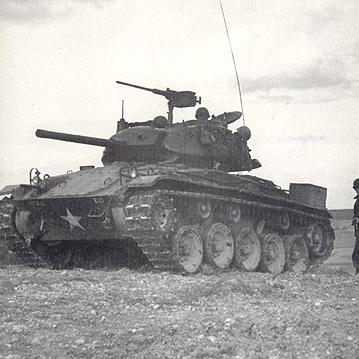 |
|
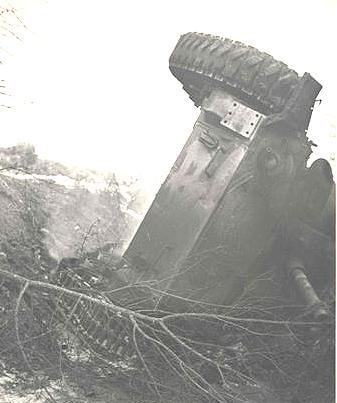 |
A nice 3/4 view of an M24 in the
field from the 1952 14th ACR unit yearbook.
--Stefanowicz |
|
Now sometimes they ended up like
this! An M24 that ended up on its side when the trail gave way at
Wildflecken. No one hurt, good thing!
--Richard Bosma |
 |
|
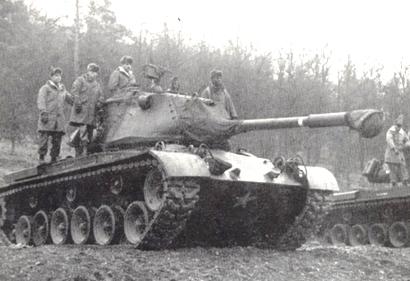 |
An image of gun tube maintenance on
an M47 from the 1952 yearbook. Clearly, the M26s were replaced
first.
--Stefanowicz |
|
An M47 on the mini tank range at
Reiterswiesen. The tank was similar in design to the M41 light tank,
the key recognition features in the fotos are the M47 has turret
blisters for the range finder and the M 47 has six road wheels.
--Stefanowicz |
 |
|
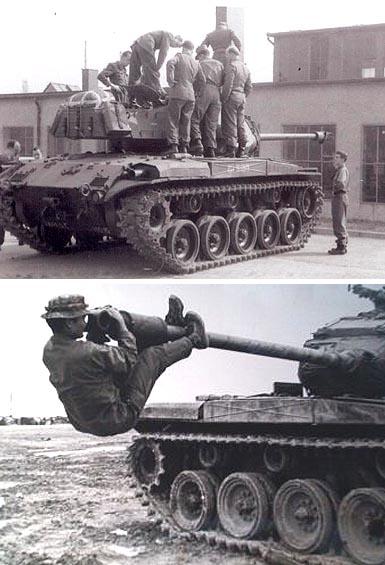 |
|
The M4 and the M26 tank seen in a
Detroit Tank Plant photo. In the opening days of the Cold War, the
M26 was redesignated as the M46 following a set of improvements,
and was the main medium - heavy battle tank available to US
forces. |
|
The M41 enjoyed a long life with
allied nations. Seen in Fulda, members of the new German Bundeswehr
receive training at Down Barracks on their freshly issued M41
tanks. Fifteen years later, a South Vietnamese tanker with his
refurbished M41.
|
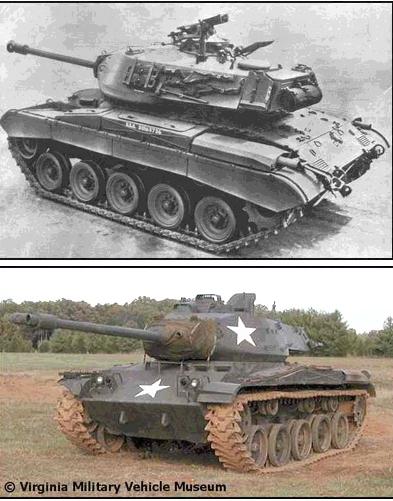 |
|
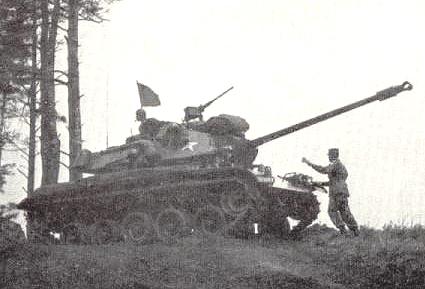 |
Two views of the M41 light tank
that replaced the M24 in the recon companies. Top is a production
image, bottom, living museum image.
--Internet Sourced |
|
An M41 is backed into a position in
this 1954 14th ACR unit yearbook image. Interestingly, the yearbook
featured very few photos of the M41. Almost all the tank images were
of the M47.
--Stefanowicz
|
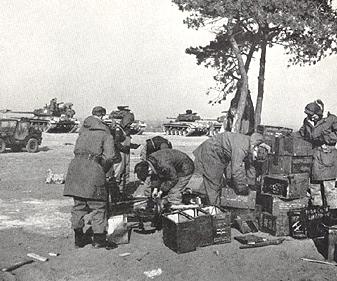 |
|
 |
In the 2nd battalion part of the
1954 yearbook, an imaged titled " crews prep for gunnery exercise ",
shows M41s on the firing line.
--Stefanowicz |
|
A production image from Hunnicutt's
great book shows the clean, clear lines of the M41. It had a short
operational life with the Army but lived for decades around the
world with other forces.
--R.P. Hunnicutt
|
Even as the M41 was rolling off the
production line, the debate over tank force mix continued.
From concept to design, then early test model, final
decision and procurement was seen as at least a six year
process. In the early 1950s, tank designers were trying to
determine where technology and demand could intersect with a
proven system for the 1960s. The Army specified requirements
to manufacturers to strongly consider a three man crew, a
better performing gun in the 76-90 mm range and a weight of
about 17 tons. There would always be a medium tank in the
Army, the light tank would fill a variety of other
operational requirements. The Army was not looking for an
incremental step but rather a large leap to embrace emerging
new technologies.
Starting with a blank sheet of paper, industry began to work
up concepts. Just like Detroit marketed "cars of the
future", the tank designers looked for radical new designs,
low and fast, light and lethal. GM's Cadillac Motor Car
Division worked overtime to produce mock ups and detailed
concepts that always received special attention at the
recurring Question Mark Conference held at the Detroit Tank
Plant. Increasingly, the requirement of "air
transportability" became a major design facet and an amazing
number of concept tank designs were proposed. By the 1955
Question Mark Conference, the requirement for an 105 mm gun
was added to the mix. Much of this design work never
progressed beyond blueprints and plywood mock ups but it
certainly had the designers looking for new solutions to old
problems.
In 1954, the Army was anxious for a design leader to emerge
as the potential replacement for the M41. Detroit Arsenal,
Cadillac and Aircraft Armaments Incorporated, AAI, all had
promising designs. An improved 76 mm cannon was allowed and
after review, the Cadillac and Aircraft Armaments concepts
were selected for funding of prototypes. But is was the T92,
of AAI that stood out and funding was soon removed from the
Cadillac prototype before it was completed. A bold new
design from a blank sheet was taking shape.
The T92 looked like nothing US tankers had seen before. The
low slung turret was positioned at the rear of the hull with
the engine and drive line pulled forward. Cupolas were
incorporated to allow both a 50 caliber and 30 caliber
machine gun to fire while under armor. There were access
doors at the rear hull to allow the crew to re-arm or leave
a disabled tank while protected by the vehicle mass. Light
weight alloys, a new fuel bladder configuration and improved
steering system were all integral to the new concept. It had
the standard crew of four, both the tank commander or gunner
could range and fire, there was a semi automatic loading
system, space for 60 main gun rounds and the ability to
automatically eject the spent shell casing from the tank.
After the prototype went through a rigorous testing phase at
Aberdeen Proving Ground about fifty design modifications
were specified. Among them, an improved shell casing
ejection system, drive line improvements and abandonment of
the "rubber band" track in favor of a more durable and
reliable track link system.
Additional prototypes were funded but in early 1957, the
program hit stormy seas. The Soviets had been parading their
interesting new PT 76 light tank and in Washington they
noticed that it could swim. In Congress, a simple question
was asked , "what was the swim capability of the T92?". The
answer was that as designed, it had no swim capability and
after extensive design review, no solution to this new
design requirement could be accommodated in the existing
program. Further funding was canceled and the designers went
back to the blank sheet.
The impact of the PT 76 Soviet light tank continued for the
next few years. In the height of the Cold War, the US Army
managed to "obtain" a complete, operational copy of the tank
and study it at the Detroit Arsenal. The technology was
considered "generally inferior" to US standards but it had
"... an unusual jet system to propel it through the water.".
This design was passed out to US manufacturers.
Government funded defense programs were making progress by
the late 1950s in a number of armor related areas not
incorporated into the T92 program. Combustible case
ammunition, originally a Navy initiative, the Army tank
laser range finder and the 152 mm cannon-missile launcher
programs were well underway and significant early successes
were reported. The programs had yet to merge but clearly,
the direction was established.
In Germany, by the middle-late 1950s, the M41-47 tank
combination was being replaced across the board with the M48
program. The Army was without a light tank and the designers
worked late into the night.
| |
|
|
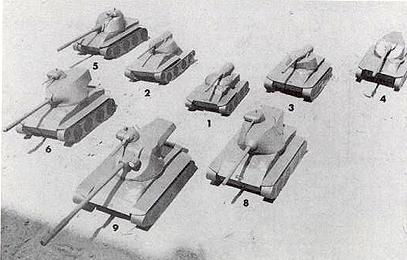 |
|
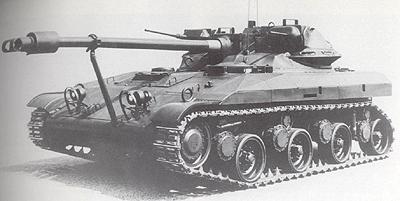 |
Fresh off the design table, a
selection of concept light tanks from the early 1950s.
--R.P. Hunnicutt
|
|
It is still a great looking design!
The Aircraft Armaments T92 project as a late model
prototype, probably from 1955.
--R.P. Hunnicutt |
 |
|
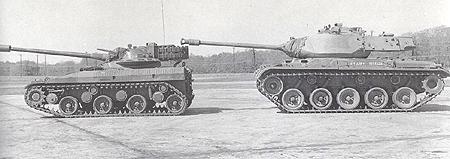 |
3/4 view from the rear, the
innovative crew doors at the rear of the hull can be seen. Also note
the unique method to carry spare track.
--R.P. Hunnicutt
|
|
This photo shows how radical the
design was, at left, the T92 and at right, the in service M41.
--R.P. Hunnicutt |
 |
Seen at APG, the little red tank
that sank the program. The Soviet PT 76 was not particularly
advanced in terms of design, but it was fast, could fight and could
float. They are still in service in some African nations.
--Gamma
|
 |
A sad reminder of the defunct
program on the display line at APG. If anyone lives near Aberdeen
and could provide some additional photos, it would be greatly
appreciated.
--Gamma |
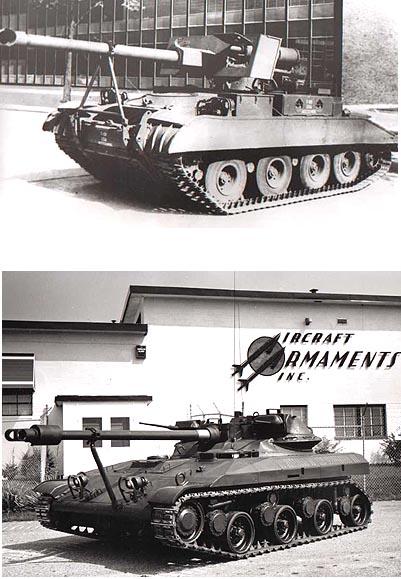 |
|
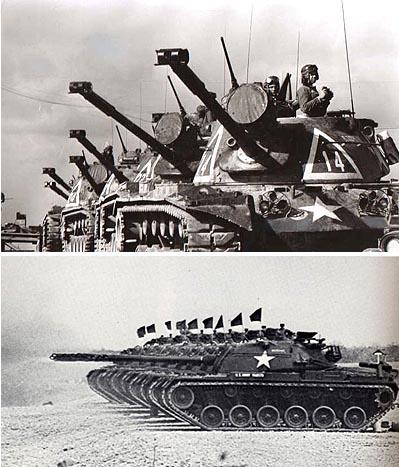 |
|
The M56 Self Propelled Anti - Tank
gun in final development by Cadillac. To meet airborne and air
transport requirements, side and top armor was deleted. Bottom
image, at corporate headquarters, one of the prototypes of the T92,
light enough to be air transportable but it had no swim capability.
US designers felt they were falling behind the Russians in armor
development.
For additional shots of
the M56 - Click Here
|
|
By 1957, the M41 and M47 tandem was
being replaced Army wide with the M48 main battle tank. Discussion
at all levels continued over the need and design of a potential
heavy battle tank and a light tank. |
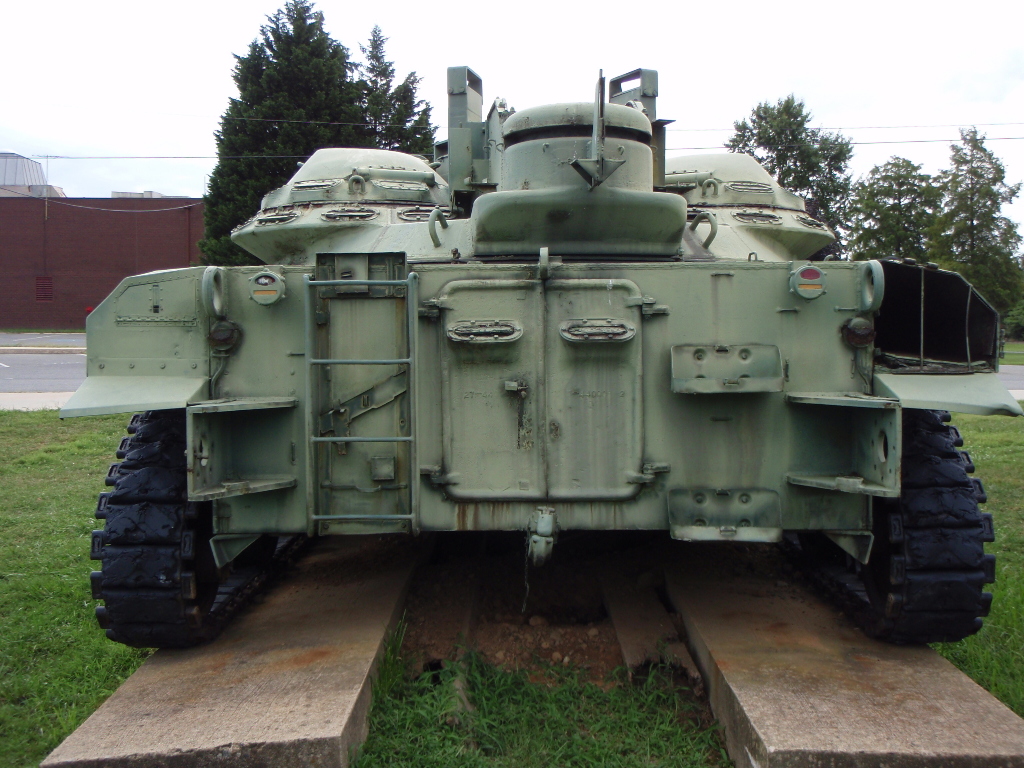 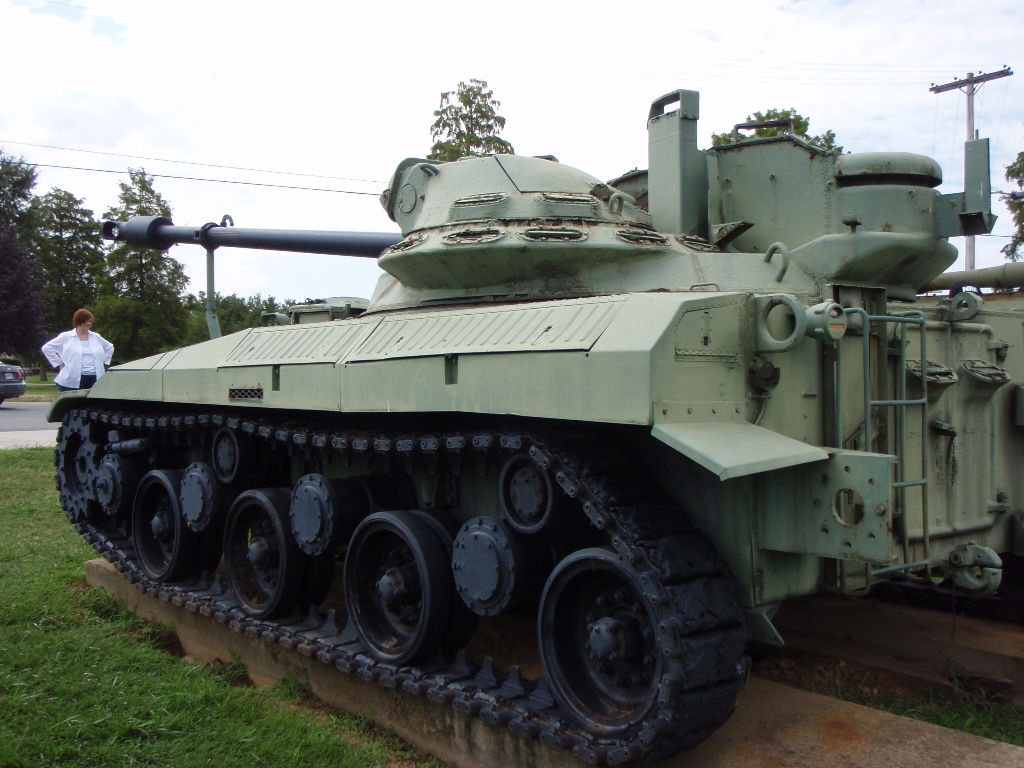 |
Our thanks to Ron Westrich who
provided these shots of the T92 from his visit to APG in Sept of
2010.
|
Without too much imagination, one can easily
visualize two mechanical engineers in discussion at the Cleveland Tank
Plant one day in late 1959. The plant was largely idle with only about
600 personnel of all skills at work. The final run of M41s had been
completed and a limited run of M114s had not yet begun. Dressed in
white shirts that hours earlier lost their starch, with the
traditional crew cuts and black framed eye glasses, the engineers
would hover over a designer's dual axis design board and consider the
state of affairs. It was not only a new vehicle but a major new
program for the Cadillac Tank Plant.
"... so lets review what they want, must be small, not much more than
maybe 10-15 tons .... must be air transportable and ... now get this,
be able to be parachuted out the back of a plane!!"
"... yeah that will work! It also has to be able to fight and move
fast. I think the requirement is a minimum road speed of 30 mph and be
able to stand up to the Russians, at least for a while ..."
"don't forget, its gotta' swim or float or not sink ... something like
that!"
"yeah ... like my boat! Look, if you take this design and fill every
cavity with some industrial foam, that adds more buoyancy than sealed
air compartments and we have already gone to aluminum over steel, you
just have to keep cutting weight and adding foam. Plus, if we use the
tracks to thrash at the water, it will move under its own power ....
sort of .... and that gets rid of your brilliant but stupid propeller
out the back!"
"the propeller or some sort of water thrust system STAYS!"
"OK ... in folder twenty-two, marked Armored Reconnaissance / Airborne
Assault Vehicle are the most recent designs that have the turret back
in front of the mid point, engine and drive line to the rear and a
four man crew. I don't care about the gun, someone else will throw
that in ... I just need it to drive, float, fight and fly!!"
All things are possible to engineers and based on the design
specifications, two groups were in competition for funding and further
development of the light tank, Cadillac at Cleveland and a joint
proposal from Aircraft Armaments & Allis Chalmers. Both companies had
started with a blank sheet of paper and the designs were a radical
departure from what tankers were familiar with. New materials and
manufacturing techniques pioneered in the aircraft industry and
opening stages of the space race held great promise.
AAI alone, also floated a plan for a remote controlled tank, that in a
working design model, had "legs and feet" and could walk, swim and dig
trenches". The Army further experimented with the design, added wheels
and visualized it as a carrier for a recoilless rifle. The New York
Times reported, "The vehicle's operator lies on his stomach and
controls the engine, which is in the rear, as well as the transmission
of power to the legs. He can turn the tank by braking the legs on one
side or stopping the side entirely.". This project never progressed
beyond the demonstration stage.
At the In Progress Review at the Detroit Tank Plant, the initial
design from GM in Cleveland won the day and the money was granted.
June 1960, the project was designated as the AR/AAV XM 551 and General
Sheridan's name was designated the following year. The program was
underway.
Sixteen months later, the Cleveland Press reported the contract had
finally been signed for production and almost six million federal
dollars were allocated to retool the Cadillac plant for Sheridan
production. Even before the final designs were approved and the
prototypes field tested, plans for production began in earnest. A work
force in excess of 4000 personnel was visualized with at least two
major production lines running at the plant, the M551 and the M114. If
all went according to plan, tank production could begin in 1962. In
the Fall of 1961, more good news, the plant received additional
contracts for both 105mm and 155mm self propelled howitzers.
During this same period, a joint Sperry and Ford Aeronutronics program
to add a guided missile component to the developmental 152 mm M81
cannon was also making design progress. It was designated as the
Shillelagh system. The M81 had already become the lead choice for the
XM 551 in the Army planning documents and the addition of a missile
was seen as a great step forward in fighting capability. Other weapons
choices had been considered but the 152 mm cannon firing a combustible
case round offered the new technology and the new approach that seemed
to best fit the Sheridan profile.
The M81 cannon has its own interesting story, although we have found
only fragments. The idea of a "big bullet" 152 mm, combined with a
missile launcher and combustible case ammunition clearly had a
powerful lobby in the Army and manufacturers. In Europe, our allies
and adversaries favored incremental improvements in tank gun
ammunition based on faster burning, more powerful propellants, new
designs in explosive and kinetic rounds and experiments with larger
gun tube diameters, 90 mm, 105 mm, 120 mm. Only the US seriously
pursued the large bore gun-launcher system. This cannon, tied to the
Sheridan, the MBT 70 and the M60A2 would have a long and troubled
history.
When the missile program showed signs of stalling in development, the
decision was made to continue the Sheridan project based only on the
M81 gun and conventional ammunition. If the missile later met
developmental milestones, it could be reintegrated to the Sheridan
program. Though the early 1960s, the first prototypes of the XM 551
were delivered to the Army for extensive testing. Designers then
incorporated the lessons learned and tried to solve emerging problems
on the ranges and test roads as well as the design studio. The program
was clearly taking shape, the later prototypes very closely resemble
the final approved design.
This is not to say, however, that the XM 551 was the only design
iniative alive. Even as the money began to flow and the M81 cannon
with combustible case ammunition programs merged with the
light-airborne capable tank program, the Army sponsored a design
contest to consider tank-like vehicles just beyond the capability of
current manufacturing. Lockheed Aircraft engineers, Robert and John
Forsyth, won the award with a radical design. The vehicle was
articulated with two crew chambers, "... combining mobility with
tactical self sufficiency. Three men including one trained in nuclear
projectiles, would ride in the forward tractor unit, with four men
including a ' tank support team ' riding in the rear one. They could
fight either from the vehicle or dismounted." . The tank would feature
a 155 mm cannon, a 20 mm cannon and a heavy machine gun, the New York
Times reported. An interesting experiment that never rolled off the
design board. In the real world, the Cleveland newspapers proudly
tracked the growing payroll, employee count and significant contracts
associated with the Tank Plant.
Congressman William E. Menshall, ( R-Cleveland ) in budget hearings in
Washington in 1963, tried to determine the value of all actual and
expected Army contacts related to the Cleveland Tank Plant. The total
expected dollar amount was fixed at 363 million, including howitzers,
the M114 and most notably the M551. With that much money at stake, the
program was close to achieving unstoppable momentum. Also that year,
as tooling continued on the M551 production line, the single shift of
3600 workers stopped for a brief ceremony; the 1000th M114 rolled off
the line in July.
In Washington, the expanding Vietnam War, space race and "guns and
butter" policies of the Johnson Administration led to huge funding
commitments and to keep projects alive, the military was asked to
review all new contacts and look for savings. In sub committee, the
question was asked, "why is Chrysler running the Detroit Plant and
building M60s and GM is getting ready to start production on tanks in
Cleveland? Does it make more sense for Chrysler to take over all tank
production?". In spite of existing contracts, the entire Sheridan
program and administration of the Cleveland tank plant was put up for
bid to drive the project cost down. Chrysler won and suddenly it
seemed as though GM would surrender the keys to the building and the
blueprints.
The news rocked Cleveland, particularly when GM announced that to
fully operate the plant under their corporate structure would take
upwards of a six month slow start program. The newspapers reported
that almost 3000 workers would be laid off. Behind the scenes, GM was
grandfathered into the production of the M109s and M114s. They would
be sub-contractors to GM in the plant, the M551 would become a
Chrysler program. Then, a few months later, the papers reported that
just the opposite would occur, Chrysler would assume the GM projects
in exchange for returning the Sheridan to GM. From union officials to
local politicians, all of this was a hugely unwelcome annoyance.
The following year, the projects at the Cleveland Tank Plant were up
for bid once more ... this time, GM won all existing contracts with
the lowest bid and planned to control the entire plant and all
production lines by mid 1965. The recently hired Chrysler workers
became GM workers, the entire work force numbered just under 2000
employees. As the M114 line completed its final copy, the work force
dramatically dropped to just over 700. Within one year, the vast
majority of union employees at the plant had drawn their cards from
one local, reported to new local and then gotten in line at the
unemployment office.
In 1965, Sheridan prototype # 12 was delivered to the Army and it
represented the final design that Cadillac and Cleveland Tank Plant
felt matched all the Army requirements and could be readily produced
at the factory. The same year, in an internal reorganization, GM moved
a management team from their Allison transmission division into the
plant to supervise all projects. The final M551 design included the
"swim screens" that anyone involved with the vehicle up to 1978 will
fondly recall. The water jet propulsion system was gone, the tracks
would thrash at the water and create thrust.
Because the M551 had been a "blank sheet" project, almost all
components had been specifically designed and hand built for the
prototypes. Actual production required a vast support network of
outside contractors and with Allison at the helm and production
seemingly safe again with GM, mid 1965 saw hundreds of suppliers and
sub contractors descend on Cleveland to attend production conferences.
Plant Manager, Mr. E. D. Solms, a life long GM executive, valued the
total dollar amount of sub contact work at 70 million for the life of
the project. With the optimism of an American manufacturer, a
businessman and a GM employee, he predicted that the M551 could serve
as the base for an entire family of US Army vehicles and that they all
would be built in Cleveland. No government money was used for these
"side projects", GM financed the additional designs. The call went
back to the union halls, assembly-fabrication workers of all skills
and trades needed at the tank plant. The M551 was the major production
line, running in another wing of the massive factory was the M109
howitzer line.
Actual production at a slow rate began in 1966 and on 29 June, the
first production model rolled off the assemble line to much applause.
General Frank S. Besson Jr., commander of the US Army Materials
Command was the noted guest and he remarked,
"This tank is a major addition to our military ' bag of tracks'. The
General Sheridan represents the first weapons system of major
significance to be developed and produced by the Army Material Command
under the project management concept since reorganization of the Army
in 1962."
The final Sheridan was produced at the Cleveland Tank Plant in 1970. A
total of 1662 were built. All of the key design criteria had been met,
it was light and could be deployed by parachute. The 152 mm cannon
with missile launcher could defeat any Soviet tank. It was small but
retained a four man crew, it was fast, 35 mph was possible with a full
combat load. The automotive platform offered a wide variety of other
possible uses and ... at about 3 mph ... it could swim.
As the vehicle went into production, staff officers created elaborate
scenarios for its use. Not unlike Star Wars twenty years later, before
there was a fully operational system, there were glowing reports
featuring great art in much of the popular press. However, at the
highest levels of the Army, many senior officers were not impressed.
The program had funding and momentum but there was a lobby behind the
scenes at the Pentagon that opposed the fielding of the M551. At a
minimum, they wanted a very slow and controlled start up.
There were many roll out problems with the system and these were
identified and corrected during the life of the production run.
Modification teams were created to chase down the fielded tanks while
the production line maintained a slow pace to adapt to changes as they
arose. The new main gun required much fine tuning and only at vehicle
#700 did the Closed Breech Scavenging System, designed to clear the
cannon of any burning residue from the combustible ammunition, become
a standard item. If at a museum, you find a Sheridan with gun tube
fitted with a standard bore evacuator sleeve, it is an early
production model. The sleeves were left on even as the CBBS was added.
Eaglehorse troopers in Germany will recall the laser range finder on
this tank; these were added well after the production line was
finished. Troopers from the Vietnam era may not recall much about the
missile launching system. Those vehicles sent to Southeast Asia
deployed without that component.
For the designers at the tank plant, watching the slow but steady
production in the massive factory must have given them a sense of
distinct pride. Years of hard work, politics and industrial
competition had finally led to the first tanks rolling off the
assemble line. There was, however, one remaining problem, the field
modification team never had to travel very far. As the final
inspection was finished for each tank by a joint team of military and
civilian technicians and it was declared ready to ship, the driver
carefully drove it to a secure lot next to the factory and parked the
band new Sheridan. In late 1968, against any potential ground attack,
Cleveland was the most heavily defended city in the United States. At
the tank plant, over 1500 M551s sat hub to hub in the snow.
| |
|
|
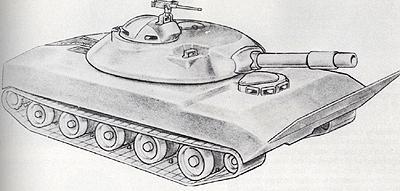 |
|
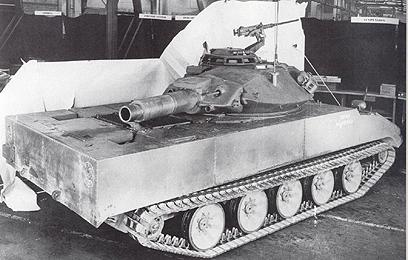 |
A very
early concept drawing for the new light tank, XM 551
from Cadillac.
--R.P. Hunnicutt |
|
Pilot #
3, hand built as the design continued to develop.
Among other areas, they were testing a caliber .50
spotting rifle mounted above and to the left of the
cannon.
--R.P. Hunnicutt |
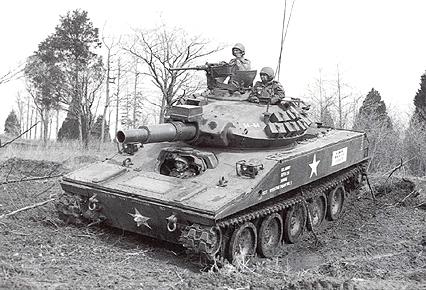 |
|
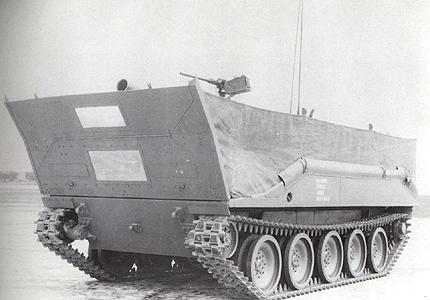 |
Pilot # 9 in the design series, this is almost the
final design that was authorized for full
production. Note the bore evacuator sleeve, the CBSS
was not yet under development. Also, by now, the
water propulsion system had been eliminated.
--R.P. Hunnicutt |
|
The surf board is in the fording position and the
swim screens, stored in chambers running along the
upper edges of the hull, are fitted together. It
wasn't pretty but it met the Army requirements.
--R.P. Hunnicutt
|
 |
A
mid production run Sheridan as it looked for a
publicity still. The CBSS is installed so the bore
evacuator sleeve is gone. Also, the metal shields
surrounding the TC position are now standard. These
photos represent a very small percentage of images
available in the R.P. Hunnicutt book. If you have
any interest in the fully detailed story of the
Sheridan or other light tank development initiatives
in the US, please order your copy now.
--R.P. Hunnicutt |
| |
In 1978, my first Platoon Sergeant, SFC Terry Sperry told very few
war stories despite two tours in Vietnam. He could go on for hours
on tank trivia and the history of the American horse cavalry in the
Southwest from the period of 1865-1885 was by far his favorite
topic. Ask how the red and white cavalry guidon evolved from the
"swallow tail" style to the modern design and stand by for about ten
minutes on topic.
Sperry had been both with the Blackhorse and the 25th Infantry in
Vietnam, his first tour had been as a Sheridan driver. He told two
Vietnam stories that I recall, the Sheridan story went like this:
"Yes, I remember them, I was a driver in 1970 when we got them. Nice
new tank that ran well as long as ... you didn't get your ass shot
off. In the base camps, we talked about the merits of driving or
being in the turret. As the driver, at any given minute, I expected
a blinding flash followed by sailing through the air as a mine went
off under my ass ... but most of the drivers I knew survived ... for
the TC and loader, sitting high in the turret ... well that's where
the RPGs always hit and I saw a lot of those guys end up in pretty
rough shape ..."
By now the Platoon Room was deathly silent, new troopers listened
with eyes the size of silver dollars .... Sperry had his audience
just about where he wanted them ...
"But I did see some pretty tough fights, took part in more than my
share when I was sure my number was about up ..."
With the constantly lit Marlboro, he was now punctuating the story
with jabbing motions with his hands, the ash end resembled a tracer
round and the smoke trails and rings ... the smoke in front of the
main gun a second after firing.
"you see ... the driver's compartment was built just at the wrong
height and just the wrong size ... in eleven months in the ' hole ',
I swear to God, if it had two wings, four feet, six legs, or 160
feet, it ended up falling into my lap. I kept a ball peen hammer
next to me, wasn't afraid of the VC, I was fighting for my life
against bugs, bats, rats and ... CATS!!"
The tension broken, the room would break out into laughter. Sp/4
Bell would say:
"Aww Sarge ... you was just telling a joke!!".
LTC (Ret) Burton S. Boudinot:
"... I asked for the Armor School Sheridan project officer, the
Armor and Engineering Board M551 test officer, and the commanding
officer of the 73rd Tank Battalion at Fort Bragg, North Carolina,
where the M551 was in operational field testing to be brought to
Vietnam. The three LTCs arrived in about a week. After a few days of
studying the proposal, we told the J3 who was studying the issue for
General Creighton Abrams, the Theater Commander, that we thought the
M551 was not well suited for Vietnam."
"' Well ' said the J3, think again. General Abrams wanted to know if
the M551 would be of ANY use at all in Vietnam. ... I then briefed
Abrams, with these recommendations: The Shillelagh missile system
and its components should stay home, and only 27 vehicles should be
brought into the country, all with added armor enhancements and
especially added belly armor."
"General Abrams said, ' Let's do it! ' ... in January of 1969 the
first Sheridans and the new equipment training team arrived in
Vietnam. The reception of the 11th ACR was cool but then on January
29, two Sheridans were on picket duty along the Long Binh highway.
At about 0230, the crewmen were alerted to movement to their front.
The Sheridan searchlights were turned on and enemy troops spotted
crossing a dirt road. Two 152 mm ' Bee Hive ' antipersonnel rounds
were fired. The next day, over 125 bodies were found."
As the vehicles deployed to Vietnam, at Fort Knox, the Armor School
geared up.
Fort Knox Training
Doug Kibbey, Troop G:
"For myself, and others, the first sight close-up of M551 in
'regulation uniform' was to be in AIT at Fort Knox on the Patton
series of MBTs when Sheridans of the 1st Training Brigade would
appear in the tank parks and on the range roads. The first
impression was usually one of keen interest bordering on awe,
because of the vehicle's exotic geometry and compact size for such
an obviously large weapon. 'What is THAT?' was a question frequently
asked."
"A lot of young tankers-in-training were soon to find out, including
this one. In the summer of 1971, approximately 33% of the 8 week
Armor Crewman AIT class was selected to report to D/1/1 for M551
training, with the entire class already knowing its first duty
assignment following that 4-week course. Roughly 50% were to be
assigned to Vietnam (including this contributor) and the remainder
to Germany, with a very few possibly to Korea."
"I was assigned to D/1/1 Training Company which was housed in some
of the last open bay wooden barracks from the WWII era. The vehicles
were equipped with the Closed Breech Scavenging System without bore
evacuators and were fully Shillelagh missile capable. Considerable
time was given over to procedures relating to this system. One
missile was fired in demo, all missile 'firing' training was
performed on a turret trainer/simulator. The vehicles were fitted
out as standard with no accessory gun shields or mine plates. This
training course was to be the only time that most Sheridan crewman
would ever see the smoke grenade launchers actually fired and two
exposures of this event are provided."
Col (Ret) Clint Ancker, Troop G:
"I attended Armor Officer Basic Course in late summer of 1970. The
course was nine weeks long. There was little or nothing on the
Sheridan until quite late when someone decided that we desperately
needed to actually shoot them before we graduated. As the course was
already set, it was decided to that we would shoot the Sheridan on
Saturday, after graduation. This was a very unpopular decision, but
there was nothing we could do about it. Many of my classmates had
already made plans to leave either Friday after graduation or on
Saturday, but these plans were now on hold."
"Saturday morning we all gathered at one of the ranges at Fort Knox
for our familiarization shoot. Many of my classmates drove their
cars to the range in order to make a quick departure. The firing
itself was almost anticlimactic. Each of us was to TC a Sheridan and
fire a round or two, for familiarization. This all went off without
a hitch, except for one of my classmates who failed to heed the
warning that the Sheridan main gun round produced prodigious recoil.
He did not hold on to the TC's station firmly when the gun fired and
ended up with a mouth full of M2 .50 caliber machine gun. This was
not the last I was to run into problems generated by the recoil of
the M551."
Vietnam
SFC (Ret) Tony Perez, Troop E:
"I was a TC and one thing I remember was that most of the time we
fired the main gun, it was more like duck hunting than tank gunnery.
I seldom recall the gunner at his position in the turret, we would
load and I'd lay the gun and just about estimate the elevation.
Because of the terrain and heavy growth, anything beyond 500 meters
seemed a very long way to shoot. We believed that if we were
standing in our open hatches and there was any sort of explosion,
you stood a chance of surviving by being thrown clear of the tank.
So, another reason for the loader / gunner to load the main gun and
get to the loaders hatch. And, he had an M60 machine gun up there
and the more people looking from the turret, the better the chance
to see and shoot first. Like most everyone else, I had the TC's
control rigged with an extension so I could comfortably be on the
TC's stand and be able to slew the turret and fire the gun quickly."
"The worst day I had without getting shot at was breaking down in a
really thick jungle and listening as the rest of the platoon
maneuvered away from me in a sweep. They said the XO would be along
really quick in the maintenance PC and they'd stay with me until the
recovery vehicle would drag me out. So, everyone was up on in the
turret and we couldn't see more than fifteen feet in any direction.
I think we waited about an hour and I could hear the Troop motors
driving away and it is a very big jungle and a very small Sheridan."
Col (Ret) Clint Ancker, Troop G:
"I joined 2nd Squadron, 11th Armored Cavalry Regiment in September,
1971. When I arrived, 2nd Squadron was the only element of the 11th
ACR still in Vietnam. The squadron consisted of three ground cavalry
troops (E, F, and G), the squadron howitzer battery, and what had
been the Regimental Air Cavalry Troop. The squadron did not have its
normal organic tank company. I was assigned as platoon leader, 3rd
platoon, G Troop and flown out to Fire Support Base Andrews to link
up with my platoon. The platoon consisted of 10 vehicles. There were
seven M113A1 armored cavalry assault vehicles (ACAV). Four were
standard configuration with an M2 at the commander's station and two
M-60 machineguns with a gun shield, mounted on either side of the
cargo hatch. Two had a 40mm automatic grenade launcher in place of
the M2 and one had an 81mm mortar in the cargo compartment (this was
a M125A1). The mortar track also had a rear facing M-60 MG."
"I also had three M551 Sheridan Armored Reconnaissance/Airborne
Assault Vehicles. Normally the Sheridan was configured with a 152mm
main gun, an M73 7.62mm coaxial machinegun, and an M2 Browning .50
caliber machinegun at the TC's station. All of the Sheridans in the
troop, and I assumed in the squadron, were configured with a second
M2 .50 cal at the loader's station. One of my Sheridans was also
configured with an M-60 MG at the driver's station. Each Sheridan
also had a mine plate on its belly. The mine plate was a Vietnam
addition and consisted of a roughly one inch steel plate that
covered the whole bottom of the chassis. This added significant
weight to the vehicle, but provided a significant improvement in
survivability from mine hits."
"While capable of firing the shillelagh missile, none of the
Sheridans carried any shillelaghs. For the main gun they carried
canister rounds and HEAT MP rounds. Most of the basic load was
canister rounds. These rounds had projectiles that looked like a
coffee can. They had a flat nose with no fuze. They contained
thousands of flechettes, small nail like darts. Each had a pointed
nose and small fins, like an arrow, swaged out of the body of the
flechette. When fired, the front and sides of the round fell away
and the flechettes spread out like a shotgun round. The base of the
round fell to the ground and when lying on the ground could not be
distinguished from a dud HEAT round that was buried in the ground."
"The best part of the Sheridan was its suspension. It could go
places that the ACAV couldn't. It had a very low ground pressure,
was very rugged, and almost never threw track. While the M113 threw
track not infrequently, the Sheridan rarely threw track. I only saw
one thrown track on a Sheridan in Vietnam. This happened in an old
trench line where the Sheridan slipped into one of the trenches and
threw a track to the inside."
"At one point while I was the platoon leader, we shifted areas of
operations. The new AO allowed recon by fire without any clearances.
The first day we were allowed to do this, I told my Sheridans to
load HEAT-MP for the recon by fire. SSG Bruce Thorton, commander of
G-38 gave me an up (meaning he had a firing light) just prior to
"open fire". When told to "open fire" everyone opened up. G-38 fired
its HEAT round and SSG Thorton simply disappeared down the TCs
hatch. After the "cease fire" someone keyed the platoon net, and
after about five seconds, SSG Thorton's voice came over the net and
he said "Why didn't someone warn me?" After the operation that day,
I talked to him and he said that it was the first time he'd ever
fired a HEAT round. The canister round was a very low pressure, low
velocity round with almost no recoil. The HEAT round was a full
pressure, relatively high velocity (relative, because the 152 gun
system was actually a low velocity cannon compared to the tank main
gun on an M-48 or M-60) round with ferocious recoil. A 152mm round
on a 17 ton chassis, caused the Sheridan to come up off the first
two roadwheels. Unless the TC braced himself, the recoil would bang
him around significantly."
Doug Kibbey, Troop G:
"The Sheridan's utility was to be tested under fire in Vietnam,
pending resolution of SOME of the problems relating to the hazards
of the combustible case ammunition for the M81 gun. Sheridans in
Vietnam service were usually assigned to light armored cavalry units
alongside M113 ACAVs, usually in smaller numbers. In 2/11th ACR, the
ratio was approximately 1 M551: 3 M113s. Like most armored vehicles
in extended combat operations, they were heavily overloaded and
being heavier and more heavily armed than the M113's, one usually
led any column in breaking bush. This led to the most frequent
mechanical difficulty with the vehicle, overheating."
"Modifications were numerous, apart from the addition of a variety
of gun shields and the mine plate kit, the most frequent involved
the extension of the exhaust stack with a metal artillery munitions
tube (to raise the exhaust plume away from the crew in heavy bush),
the addition of an M60 or M2 machine gun at the loaders hatch, an
additional stowage rack welded to the rear deck, and frequently the
relocation of the commanders' turret control handle to a position
virtually outside the turret in the TC's cupola. Given the threat of
mines and RPGs, crews of M551s and M113s tended to ride outside of
the vehicle with no one inside except the driver, who often
reinforced his position with sandbags inside and/or out. Few M551s
in Vietnam retained a full compliment of swim gear, which fell
victim to the rigors of busting bush and was subsequently
cannibalized as tenting or construction material. The only
contribution of the side mounted floatation pods was to possibly
attenuate the effects of shaped-charge weapons and other fire."
"On patrol, the TC generally acted as his own gunner with the
relocated remote turret control handle, typically "firing from the
hip". The round most often chambered was the 'canister' round
containing ~10,000 flechettes (darts) usually just referred to as
"nails", which is what they amounted to. HEP rounds were also
carried in the event a bunker or hardened position was encountered.
At best, the main gun was bore-sighted, as tank v. tank engagements
did not occur."
"I was among the members of G Troop, 2/11th ACR when the squadron
stood down in March-April 1972. The vehicles were driven to Long
Binh depot and prepared for shipment (the M551s) to the United
States, or hand-over to the ARVN (the M113s)."
LTC ( Ret) Lee Allen:
"While with the second squadron in Vietnam, I had the opportunity to
see a couple of Sheridans hit by RPGs. Once the combustible casings
caught fire, which was almost instantaneously if they were hit, the
whole vehicle exploded and burned. Because of the aluminum hull, the
end result was a big puddle of molten metal on the ground and the
loss of the entire crew."
"The firing system was what seemed like an endless series of
electromechanical switches any one of which could shut down the
whole system. It was a terribly frustrating thing to have to trouble
shoot the system to locate some mechanism breaking the circuit. This
was especially true in Vietnam where the heat and humidity raised
havoc with the temperamental system. The ever ingenious troopers
solved the problem, if you can believe it, by running a piece of
WD-1, commo wire, from the electrical firing mechanism (firing pin,
you might call it) to the overhead dome light. When the tank
commander gave the word to fire, the loader would reach up and turn
the dome light on. It worked."
The Sheridan was fielded to most of the cavalry squadrons in Vietnam
over a two year period. Almost as soon as the fielding was complete,
the withdrawal of US forces was well underway. It did offer
commanders a vehicle that could accompany the M113s where the M48s
could not follow. The bee-hive round on occasion, could yield
dramatic results. Like much of Vietnam, it was all done with the
best intentions. The Sheridan was an answer in search of a question.
Many of the problems discovered in this harsh environment would
continue, only partially solved, for the life of the system as a
combat vehicle. Even without the laser range finder and missile
components, the turret was prone to electrical problems. The CBSS
fixed some of the cannon problems related to clearing the tube
immediately after firing but the complicated and touchy breech
block, that to work correctly would unscrew, swing and pivot, never
was fully trustworthy. The combustible case ammunition was ill
suited to the humidity in Vietnam, the rubber "baggy" that held the
propellant and was a part of the round would easily tear and spill.
The mechanical problems, overheating and chronic belt and pulley
failures were eventually solved.
(Col
Ret) Chris Conrad
"I commanded the Eaglehorse Squadron
in 1978 - 1980 and was present for the M551 Sheridan turn in.
Before that assignment, I was at the Pentagon and was both '
behind the scenes and behind the screens ' when the decision was
made to remove this vehicle from much of the armor force. "
"I had not had great direct
experience with M551s prior to Bad Kissingen; we had tanks while I
was a platoon leader and troop commander. We had them in
the 3rd Cavalry at Fort Bliss, but since I was the
Regimental S-4 and S-3, I didn’t have any immediately assigned. I
did have to wrestle with the maintenance and gunnery problems
though, and saw and heard all the anecdotes, such as the B Troop
Sheridan that fired a main gun round when the TC hit the radio
mike switch; and the #3 roadwheel that was blown off when the gun
fired. However, it didn’t take very long in BK to figure out I
didn’t want to go to war at Oberfladungen with the Sheridan."
"I was in the room in the Pentagon,
in the summer of 1977, when the decision was made to phase out
both the Sheridans (except for the 82nd Airborne) and
the M60A2s. I was pulling slides in the behind-the-screen
projection room for BG Lou Wagner as he was briefing the Chief of
Staff (Shy Meyer), The TRADOC Commander (Donn Starry), the AMC
Commander (John Guthrie) and other luminaries. We were briefing
the results of our study which was to determine how many M1s to
build and distribute. Part of the question was what we were going
to do with the Sheridans and the M60A2s and when were we going to
do it. Our briefing was very flexible: while I was putting slides
on the viewgraph, Tom White (later RCO and SecArmy) was busy
preparing the next slide. We were hard pressed to stay one step
ahead of BG Wagner, but, we managed. Tom’s pre-West Point
experience in graphical arts truly paid off."
"The first part of the briefing went
well, but then the question about what to do with the Sheridans
came up. Then things began to get hot. Actually, from Tom’s and
my perspective, that’s when things became fun. The briefing
stopped as General Starry began to explain all the problems with
the Sheridan. At this point, General Guthrie got a little
defensive and began to defend the Sheridan program from the AMC
perspective. Of course Starry had just left command of V Corps,
he had been the Chief of Armor, he had been the Blackhorse
Commander in Vietnam, and he was at that time, THE Army’s expert
on armor and armor operations. His focus in 1977 was Europe, he
knew the GDP, and he knew how many targets the Regiments would
have to 'service' in the now quaint lexicon of AirLandBatttle —
which he later developed as the TRADOC Commander. In short, it
was no contest; although I thought (hoped) Gen Starry was getting
ready to leap across the table and take on the AMC commander.
Starry gave his usual eloquent, though impassioned, rationale for
getting rid of the M81 (is that right?) gun/missile system in
whatever vehicular variation. Gen Meyer agreed and the Army got
rid of both the Sheridan and M60A2 with all deliberate speed."
"It made sense. A simple analysis
of the covering force mission showed that the Sheridan was a
disaster on the border. To be successful, we had to kill a bunch
of tanks, very quickly, and then move, also very quickly, to the
next position under cover of the confusion we had just generated.
The Sheridan could move. In fact that was the one element that
the troops missed when we turned them in. They could scream into
a village, come to a skidding stop on the wet bricks, slam it into
neutral steer, do a 180, and exit the village before the opposing
tank commander could get out a fire command. Still, we needed
lethality as well as agility for the mission. We were not going
to kill a sufficient number of T72s with slow firing,
rainbow-trajectory, ballistic-reticuled M551s."
"Having been through numerous new
equipment exchanges during my career, I don’t remember many
specific details of this one. There was quite a bit of detailed
planning and preparation at Regiment and at the Squadron. I do
remember that the day of the turn-in was a beautiful, sunny day in
BK. The troops did their usual marvelous job, the transfer went
smoothly, and it was exciting to get our hands on the tanks. The
Sheridan scouts had to learn how to operate an M60A1 (Rise -
Passive, I believe) of course, with the help of H Co; but once
they did, I was comfortable with their proficiency."
"One Sheridan anecdote: As you may
recall, when parked, the Sheridan gun tube was directed over the
left sponson and depressed. LTG Sid Berry, the V Corps Commander
came to visit us in the spring of 1978. This was also during the
time when our wearing of the black beret was becoming an Army-wide
issue. I was leading him through the area as he inspected the
Squadron and as we made our way through the tricky footing of one
of the Cav Troop’s motor pool, he hopped over a curb, banged into
a gun barrel and planted the three stars on his hat into his
forehead. As we walked back to the Squadron aid station, I
couldn’t help but point out that one of the reasons the beret was
advantageous around armored vehicles was that it didn’t have a
bill to block your vision. A great point, I thought, but perhaps
lost on the Corps Commander in his pain and embarrassment."
"In summary, the Sheridan joined the
M114 as a great design in theory; but, very troubled in the
field. Fortunately we didn’t have to fight them."
| |
 |
3rd
Platoon Barracks of ‘D’ Co., 1st Bn., 1st Training
Bde. for M551’s.
WWII open-bay barracks East of NCO Academy at Ft.
Knox-1971.
(D. Kibbey photos) |
 |
D/1/1 M551 Sheridans on the firing line, early
morning, Ft. Knox-1971.
(D. Kibbey photos) |
 |
D/1/1 M551 Sheridans on firing line in morning fog,
Ft. Knox-1971.
(D. Kibbey photos) |
 |
D/1/1 M551’s on firing line with downrange view, Ft.
Knox-1971.
(D. Kibbey photos) |
 |
D/1/1 M551 Smoke Grenade Dischargers fired in
demonstration. Single vehicle firing full salvo well
downrange at Ft. Knox-1971.
(D. Kibbey photos) |
 |
|
 |
M551 of G Troop, 2/11th ACR advances on morning
patrol in Hau Nghia province, Vietnam-1972.
(D. Kibbey photo) |
|
Vehicles G37 & G39 at a Night Defensive Perimeter (NDP).
Note G37 has lost most or all of its swim gear
whereas that of G39 is largely intact. G37 has just
refueled and taken on another case of C-rations,
seen on the front deck. G39 is being prepared for
movement from this particular NDP and the extreme
load-out is obvious in this picture. Shown are the
stowed RPG net, the additional stowage rack for
jerry-cans welded to the rear deck and just visible
is the modified exhaust stack, extended with an
artillery munitions tube to raise the exhaust plume
away from the crew in heavy bush. The white
Styrofoam box was used to deliver ice-cream & saved
as a cooler or, with the bottom cut out, could serve
as an improvised latrine. Still in Hau Nghia
province, Vietnam-1972.
(D. Kibbey photos) |
 |
|
 |
M551 "The Godfather" of ‘G’ Trp., 2/11th ACR seen
passing through the same fuel point as G37 in the
previous photo, but in the opposite direction.
Visible are the fuel blivet from which refueling was
accomplished, a pile of various boxes of re-supplied
ammo and rations, as well as the "trash point", to
the front left of the vehicle. Like G37 in the
previous photo, "The Godfather" is missing most or
all of its’ swim gear.
(D Kibbey photo) |
|
M551 of ‘G’Trp, 2/11th ACR assumes a forward
position to advance through an area of heavy bush
deemed suspicious in Hau Nghia province.
The daunting firepower of the 152mm gun loaded with
canister round and augmented by heavy automatic
weapons made the Sheridan especially useful in this
role. The main gun is under the control of the TC,
whose turret control handle is re-located up in the
TC’s cupola for "shooting from the hip", the
traditional gunner’s seat is unoccupied.
(D. Kibbey photo) |
 |
|
 |
This M551 of ‘G’Trp, 2/11th ACR refueling at an NDP
gives an excellent view of several typical
modifications, including the added stowage rack on
the back deck, extended exhaust stack, and addition
of an M-60 7.62 MG at the loader’s hatch mounted on
a .50 cal. pintle and feeding directly from a
mini-gun ammo can. Against all probability, the swim
gear visible has survived, as have the smoke grenade
launchers that were seldom, if indeed ever, used.
(D. Kibbey photo) |
|
C14, ‘C’ Trp., 1/11th ACR. Hull side armor and
flotation material has been exposed by the force of
a land mine explosion removing much of the metal
skin cover to the flotation foam. The hull was not
damaged, so there was no replacement of the vehicle
by Direct Exchange.
(R. Lingle photo) |
 |
Before-and-after views of G29, that suffered damage
from a large anti-vehicular mine. In the first
photo, it is seen fully laden for march and in the
second, as it was delivered by trailer to Long Binh
depot during the stand-down of the 2/11th ACR in
1972. This was one of the last vehicle losses to the
unit before standing down. As can be seen, the
explosion has caused the loss of the left front road
wheel, and apparently all of the road wheels on the
right side. The driver was blown from his hatch onto
the ground with an injured hand. TC, loader & gunner
were blown off to the sides with minor injuries.
Crews were not always so fortunate.
(R. Lingle & D. Kibbey photos) |
 |
|
 |
This vehicle of ‘G’ Trp., 2/11th ACR shows the
effects of an RPG strike on the left front flotation
pod area, probably saving the hull (and the driver)
from a complete penetration.
(R. Lingle photo) |
|
Night fire with tracer from the M2 .50 cal MG at an
NDP in Hau Nghia province, 1972. The vehicle is
assigned to ‘G’ Trp., 2/11th ACR.
(D. Kibbey photo) |
 |
|
 |
|
‘G’ Troop column stopped in heavy bush while the
Howitzer Battery FO attempts to de-fuse a dud
artillery round that might easily be converted to an
anti-vehicular mine. The picture is taken from the
TC’s cupola on an M551 (note bandolier of M16
magazines) and looks back on the Forward Observer’s
M113 ACAV (note the crossed cannons of artillery on
the .50 cal. gunshield). Another M551 can be seen
further back in the column.(D. Kibbey photo) |
|
"The Godfather" again, on the outer ring of an NDP
being scouted by a UH-1D of the flight platoon
following some suspected activity beyond the
perimeter earlier. The fire visible in the bush
beyond and above the transmitter box was started by
tracers from the coax or .50cal. The individual in
the foreground is the troop medic, obviously relaxed
now that it is established there are no casualties.
He was based on the vehicle from which this photo
was taken.
(D. Kibbey photo) |
 |
Incomplete panoramic of a completely dark night
illuminated only by hand rocket flares at an NDP in
Vietnam-1972. Approximately 1/3rd of the entire
scene is missing from the center of this composite
of two separate exposures made from the same
location. Smoke hanging in the air is from gunfire
and the absence of any troops in the tents or
dug-outs indicates this was during a probe of the
perimeter or tripping of a flare trip-wire.
(D. Kibbey photos) |
 Two
M113 ACAV’s sandwiched between two M551’s preparing
to move out, breaking camp to patrol and establish
an NDP in another location. The ratio of M551’s to
ACAV’s was somewhat less than this photo would
suggest. ‘G’ Trp., 2/11th ACR - 1972. Two
M113 ACAV’s sandwiched between two M551’s preparing
to move out, breaking camp to patrol and establish
an NDP in another location. The ratio of M551’s to
ACAV’s was somewhat less than this photo would
suggest. ‘G’ Trp., 2/11th ACR - 1972.
(D. Kibbey photo) |
|
 |
| |
|
Column of vehicles on patrol in Hau Nghia province,
1972. This area shows evidence of fire, defoliation
efforts, or both at sometime in the past.
(D. Kibbey photo) |
 |
|
 |
M551 of ‘G’ Trp., 2/11th ACR on one of its periodic
stops at Fire Support Base "Fiddler’s Green". Such
stopovers permitted rest, more extensive re-supply
and maintenance, such as can be seen being performed
here. Notice the extensive supply of 7.62 and .50
cal ammo boxes in the turret bustle. The driver has
supplemented his protection with sandbags on the
front glacis, and very likely on the hull floor as
well. In the background can be seen an M577 Cmd.
vehicle, an M113 ACAV (possibly a "thumper" track
from the supplemental flotation gear) and several
M109 155 SP guns of Howitzer Battery, 2/11th ACR.
(D. Kibbey photo) |
|
A great day for the 2/11th Cav. Vehicles moving in
column along QL13 in Binh Duong province short of
the Saigon River for final turn-in at Long Binh
depot. Note that the vehicles have been stripped of
all accessories and minor armament. This picture was
taken perhaps 2 weeks prior to the beginning of the
Spring Offensive of 1972.
(D. Kibbey photo) |
 |
|
 |
|
A "death card" of ‘G’ Trp., 2/11th ACR. When not
available, a substitution with a ‘Blackhorse’
shoulder patch might be made. |
|
The M551 as Vietnam-era "art". This is a black-light
poster in the author’s personal collection from
approximately 1972. Prescient in its list of venues,
Panama (where M551’s saw service with the 82nd Abn.)
and Afghanistan are mentioned, among other places.
The message is intended as a double-entendre, but
the poster has undeniable appeal. Clearly based on a
photograph (and an ‘E’ troop, 2/11th ACR vehicle, at
that!) no casual artist would have thought to
specify an actual serving unit at troop level,
complete with ‘mermite’ can, C-ration box, and other
paraphernalia of combat in such detail.
(D. Kibbey photo) |
| |
|
|
Prelude
With less than six months combat experience in Vietnam, the reviews
were decidedly mixed regarding the utility of the Sheridan. The combat
soldiers did the best they could, reported persistent problems, worked
with both civilian tech representatives and their own maintenance
personnel to find solutions. Engine cooling problems, continuing
malfunctions with the combustible case main gun ammunition and a wide
variety of electric problems were major issues of concern. The initial
maintenance summery detailed, "16 major equipment failures ((not
otherwise defined)), 123 circuit failures, 41 weapons misfires, 140
ammunition ruptures, 25 engine replacements, and persistent failures
related to the 152 mm cannon". This report reflected the trends
reported by the two squadrons of the 11th ACR with the Sheridan, a
total fleet of 64 vehicles. The report did note, however, that the
learning curve although steep, did indicate that more experienced
crews had greater success with the system.
The M113s and M48 tanks were hardy vehicles and with comparatively
little attention, functioned well in the heat and brush-jungle of
Vietnam. On the other hand, to make the Sheridans reliable demanded
near constant crew attention, either checking, adjusting or cleaning
components of the vehicle. Additional Sheridans were dispatched to the
theater, in Washington, battle lines were drawn.
A long delayed and very expensive program, the M551 had many critics
and with a less than spectacular initial experience in Vietnam, the
House Armed Services Sub Committee held hearings in the Spring and
Summer of 1969 to examine the entire tank program. A report by the
General Accounting Office investigating the Sheridan program noted,
"... not one Sheridan as originally designed and produced was suitable
for combat use without extensive retrofits ..."and that hundreds of
unissued tanks in depots that had passed the final military-civilian
joint inspection, were defective and not ready for deployment.".
This was not the first time that a Congressional sub committee had
called the Army to account for a tank program. In the Summer of 1960,
the General Accounting Office had drafted a report challenging the
readiness of the armor fleet and the M48 in particular. The report
noted a major malfunction rate of one event per thirty-seven
operational miles at the three Army installations studied. The
Secretary of the Army, Wilber Brucker, countered that the GAO did not
understand the readiness reporting program and that a tank
"dead-lined" at 0700 hours for low oil, was combat ready at 0705 once
the crew addressed the issue. They argued back and forth for six
months; Congress accused the Army of inaccurate and less than honest
answers and noted that the entire maintenance records of one division
appeared to have been "thrown away and then rewritten ...". By
November, the investigation had run its course. The sub committee
believed the tank fleet was not combat ready and Secretary Brucker
flatly rejected the findings. Nine years later, the politicians,
accountants and generals resumed the battle.
In testimony, a running figure of 1.3 billion dollars from design to
manufacture to limited fielding was quoted for the Sheridan program,
in budgets of the day, a very substantial figure for an Army program.
Samuel S. Stratton (Dem. upstate New York) summed up the feeling of
the committee, he noted the entire program was a display of "bumbling
ineptness". Much of the early testimony focused on the M81 cannon and
the ammunition problems. This cannon was the central feature for much
of the US armored force new generation, M551, M60 A2 and MBT 70, and
it was still a very troubled component.
Major General Roland B. Anderson, Director of Material Acquisition,
detailed how the production of the Sheridan was continued in the mid
1960s despite the main gun problems; the feeling was that the problems
related to the missile and cannon would eventually be solved and that
the Sheridan program could not be allowed to go dormant, too much
money had already been spent. He also testified that 300 completed
M60A2s and an additional 243 M60A2 turrets were in storage waiting for
resolution of the gun and fire control issues. This program would
continue once the "fixes" occurred. It might appear as though every
safeguard in the life of a major equipment development program had
been ignored; but he testified the "closed breech scavenging system"
currently being retro fitted into the fleet solved many but not all of
the M81 problems. Army officials also testified that the "urgent need"
of the Sheridan for Vietnam service required a "fast track" outside of
normal review. The sub committee noted that they felt the Army
witnesses displayed a "total lack of candor".
The hearings continued through mid Summer; problems and cost over runs
of the MBT 70 program were examined, the failure of the first turret
stabilization system for the M60 fleet was examined. The focus turned
back to the M551 and Col Merritte W. Ireland, 11th ACR Executive
Officer in Vietnam, was called as the expert witness for Sheridan
experiences in combat. He noted, "It is a fine vehicle for Vietnam".
The hearing closed, and although not written into the final record
there were three conclusions in the halls of Congress: the M60A2
program needed specific attention and probably should be killed, the
MBT 70 program should be reviewed and almost certainly would be killed
and that Chrysler, manufacturer of the M60 series, would have the
inside track for future tank development. The much troubled M551, with
the production goals nearly met, would be fielded if for no other
reason than some improvements with the cannon had occurred and the
major costs of the program in development and manufacturing had
already been paid. The fielding program for the M551 began for 7th
Army in Germany in the late 1969 with at least two divisional cavalry
squadrons first up. It appears as though the 2/14 ACR, attached to the
2 ACR, was the first USAREUR regimental cavalry unit to draw the new
vehicles.
M551 fielding to the 2/14 ACR
Col (Ret) Norm Harms
"I was the SCO of the 2/14 ACR during this period and I do not have a
strong memory of the initial fielding of the M551 to the unit; we went
through a lot of equipment changes in 1969-70, fresh M114A1s, exchange
of the cav troop M60s for M60A1s and then, the Sheridan draw, much of
it blends together. We were attached to the 2 ACR at the time and we
were the first squadron in the regiment to receive them. We very well
may have been one of the first unit in USAREUR to receive them. During
the issue of the Sheridans, I was not impressed by the personnel,
civilian and military conducting the hand off and training. It seemed
far from an "A" team. I do recall the first major gunnery at GTA late
that Fall because I changed command immediately afterwards and
returned to Vietnam."
"I was not a fan of the M551 and felt the fielding had been a rushed
operation. Once we had the vehicles, all the problems came to light,
the turret and fire control had a host of electronic issues and our
turret mechanics had received only an OJT exposure to a very complex
machine during the hand off. Fort Knox was very slow in catching up
with the fielding plan in terms of sending school trained personnel in
any of the key MOSs. Maybe everyone was going to Vietnam but that
problem should have been identified earlier."
"When we went to GTA for Level 1 gunnery, I left three Sheridans at
Daley, they simply could not be made ready to fire. Once at Graf,
other maintenance problems began to reduce our fleet of Sheridans and
I was amazed that there were no floats available when maintenance
problems occurred that could not be solved quickly. This led to
rotating crews through the tanks that did function properly. I think
we qualified about ½ of the crews; considering what I felt was a poor
new equipment fielding plan, lack of school support and lack of
adequate support at the MTA, I was not disappointed in this result.
Upon return to BK, we had the change of command and LTC Tuggle took
over. I figured things would improve with time but I wished him much
luck with the Sheridans."
Terry R. Smith
"I was a SP/5 in Troop G during the fielding and I certainly recall
those days. Anytime you get something brand new and unusual, it sticks
to your memory plus, I was selected with another trooper to help out
with driver's training of the Sheridan when it was issued in Fulda and
Bad Hersfeld. Here is how I recall those days."
Part 1
"In July of 1970 I came back to G Troop after 30 days leave in the
states. The 2nd Platoon was up on the border at Camp Coburg so I was
transported from BK up to Coburg. After finishing our tour on the
border the unit came back to BK. From BK we were transported by rail
to Vilseck near Graf to receive the new M551 Sheridans. At the time
all we knew was that were going to pick up some new vehicles for the
unit, we had no idea that we were going to be getting new "tanks" and
give up our M60s and M60A1s. You can imagine our surprise when we were
led up the hill past the mess hall at that time and down the road to a
medium size hard stand and shop type building and rows of what
appeared to be brand new vehicles of some type covered with tarps and
with wood crates on the back deck. We were told to go pick a vehicle
and once we did it was ours. The vehicles were lined up in such a
manner that each troop had a row of them before we were turned loose
we were told that they were M551 Sheridans. Well all I knew about the
Sheridan was that some of my buddies in AIT at Knox had been sent to
Sheridan School after AIT. Back then, assignment to Sheridan school
meant a trip to Vietnam."
"So some of us were quite concerned as to what the hell was going on
and why everything up to this point everything had been so hush-hush.
We all knew that in the last seven or eight months we had received new
M114 A1E2 (Not sure on the exact model) that were equipped with
Hispano-Suiza 20 mm cannons which had been a hell of an upgrade from
the .50 Cals the old ones had. We had received new M113A1s and new
M107A1 4.2 inch mortar carriers. So a rumor started running through
the Squadron that said we were going to Vietnam which made some sense
to us since we had all new tracked vehicles in the recon troops and H
Company got the pick of the best M60A1s to keep and we turned in all
the junk."
"It was August of 1970 and we were at Vielseck. The weather was
beautiful. We were in the cinder block barracks with our own mess hall
not too far from the issue and training point. All together, there
were probably less than 150 guys from the squadron involved in this
affair. The actual draw of Sheridans was a straight swap of the recon
troop M60s for the M551s; three per platoon, nine per troop and so on.
We still had the M114s, five per platoon, and Sheridans at this ratio
until I left BK in 1971, what an organization ... Sheridans and M114s!
It must have looked great in Washington but in Germany, it was all
problems all the time. All soldiers complain, I know that, but with
that set of combat vehicles, believe me, we had a lot to complain
about. But when we were getting the new tanks at Graf, we were like
kids on Christmas morning. It was all new and exciting."
"But getting back to the story, once they turned us loose it was like
letting a bunch of kids loose in a candy shop, we used no logic what
so ever on which M551 we picked out as a crew. It was just first come
first served. Because I was on the Tank Section Sergeant's crew we
picked one out and promptly christened it G26. We had to be restrained
from going nuts and ripping open and scattering all to hell the gear
in the wood crates secured to the back deck. We started opening them
up and they were full of new weapons and gear for the new M551s. I
mean new M2 .50 cals no more M85s which we thoroughly hated because it
was pain to load the TC ammo box and it only held 75 rounds and with
high and low firing speed it only took an fraction of a second in high
mode to burn up 75 rounds. There was a new coax, the M73A1, and new
barrels and new this and new that ... you had to be there to see our
excitement but it was excitement tempered with the nagging question, '
Why are we getting all this new gear? ' ."
"The senior NCOs and officers stopped us from spreading new gear from
asshole to appetite saying slow down and don't take it out of the
boxes we have to inventory everything to ensure the old man, Lt. Hurd
was getting what he was about to sign for. So that's kind of how the
first day ended with us just wandering around in fine mill around mill
fashion still kind of star struck as to just what the hell was going
on. PS: it had the biggest god damn main gun we had ever seen 152 mm
and it fired some kind of missile they called a Shillelagh missile,
which I knew stood for a big club in Irish. Plus I got a hold of a
really neat little book out of one of the boxes with the title of M551
Sheridan Weapon System Handbook. And, the turret inside looked like
something out of 2001 and Space Odyssey or the Apollo moon program
with switches and colored lenses (which we later learned to cuss
about) and a couple of big gray bottles and some damn thing under the
loaders seat which was to damn small."
Part 2
"The days after being introduced to our new steeds were filled with
inventorying issued equipment, cleaning cosmoline off of new crew
served weapons, packing issue equipment away and a hundred other
things related to receiving new tracked vehicles. We studied TMs and
the M551 handbook and became familiar with the engine, transmission,
main gun hydraulic system, closed breech scavenger system, electric
turret operation and controls, main gun primary and only day light
sight, the near IR, or Pink light as we called it, sights and the
Missile Control System and aligning the missile sight reticle and
missile tracker, removing track pads to shorten the track and a
hundred other tasks."
"Eventually the time came to start to putting them through their paces
so we could see what they would do. So we began to take the whole
Squadron out and road march the Sheridans. Because we were short
personnel I got to be both Driver and Loader. Compared to the
acceleration of a 60 ton M60 series tanks these things could fly or so
it seemed to us, hell no APC would leave us in the dust any more, but
a couple of things we noticed were that the engine had a hell of a
whine from the turbo and it became evident that you could see that
exhaust rooster tail for a ways."
"The second road march we took was to a range were the main gun was to
be proof fired. When we arrived at the range the vehicles were guided
to a spot on the firing line and the crew was told to go get a main
gun round and load it in the breech, leave the safety on and then get
out but leave the master switch on. On my way out of the driver's
compartment I thought for a second and remembered to pull the main
gun's barrel plug out. The other guys in the crew loaded the main gun
round that had been given to us. We all went about 50 meters to the
rear of the vehicle and stood around watching the show, smoking
cigarettes and acting cool."
"As we stood there we watched two guys, a couple of civilians, go
around to each Sheridan one at a time and climb on board and disappear
down the loaders hatch. After a few minutes they climbed back out and
were trailing a long electrical cable and what appeared to be some
type of thumb switch. After they were clear of the vehicle and about
half way back to were we were standing they stopped and the Range
tower announced the unusual is there anybody down range, after three
or four of these announcements, one of the guys pushed the switch and
the main gun went off, and that is proof firing. I guess they were
proving to us that the damn thing wouldn't blow up on us when it was
fired, or at least making sure that no one was hurt if there was any
sort of problem with the very first round."
"One thing we immediately noticed was the vehicle clearing the ground
with the first three road wheels, the tremendous movement of the
vehicle and that damn big cloud of crap out of the main gun that from
where we were standing, seemed to obscure the TC's vision. We all
commented immediately how it appeared that if you tried to sense the
round with a pair of binoculars from the TC position you'd probably
get them slammed through your skull and it would come out the back of
your head. It was immediately apparent to us that we'd have to figure
out a way for the TC to sense rounds without having the binos
blackening at a minimum both his eyeballs."
"While we were bull shiting about this new problem we had seen, one of
the guys from 1st Platoon came up and asked me what I had in my hand?
Well I looked at him like he had just came from the planet Uranus and
said it's the main gun barrel plug, what the fuck do you think it is,
a rubber? Well, his eyeballs got as big as silver dollars and he
blurted out that he forgot to pull his out. Welllllllllllllll! At
about that time the main gun on his Sheridan went off and there went
his fuck'n barrel plug up and down range. It turned out that only
about a third of the crews in the Squadron had remembered to pull
their barrel plugs soooooo there were about or fifteen plus barrel
plugs that went down range never to be seen again."
"Most of the crews by that point were aware of their mistake before
their main gun was fired. But, because the main guns were loaded they
couldn't approach their vehicle to pull the barrel plug and the
civilians said tough luck and kept on hooking up to the firing
circuits and firing the main guns. So the crews in the G Troop, 2nd
Platoon Tank Section who had pulled their barrel plugs spent the next
hour or so watching the facial expressions of the other crews as their
main guns were fired. You could tell which ones hadn't pulled the
barrel plug out because their TCs were standing with their crews
rolling their eyeballs and chewing their gunners out. So ended the
proof firing phase and began the steal yourself a new barrel plug
phase."
Part 3
"After the Main Gun Muzzle Plug up and down range fiasco, it was every
crew for themselves when it came to muzzle plugs, our section took
ours and painted them with our vehicle numbers on the inside. If
anyone stole it, all we had to do was go around pulling them until we
found the one that belonged to our vehicle. I mean this was a crisis!
Without a muzzle plug all the cleaning done to the main gun was for
naught because once you went on a gravel road or road march the inside
of your main gun bore was full of dust and crap and that didn't bode
well for troops who did not like to clean their main guns anymore than
we needed to. In reading through the TMs it was listed that we were
suppose to clean the main gun with some type of special bore cleaning
solvent and use a bunch of other types of cleaners and oils. Well
because it was the U.S. Army we are talking about, we had none of this
stuff and never did, even up to the time I PCS'd back to the states in
June of 1971. Doing what all good cavalry troopers do, we improvised,
we mixed up a little diesel fuel some one gallon cans of rifle bore
cleaner some L.A.W, M16 rifle lubricant at the time and proceeded to
clean out our main guns for three days after firing. After the third
cleaning we stuck the bore plug in and forgot all about the main gun."
"In the mean time some of the sharper troopers from the crews that
sent their barrel plugs down range discovered that if you took the
rubber bag that covered the combustible cartridge case for the
conventional main gun rounds, you could use it as a main gun barrel
prophylactic. It looked like hell but I guess it worked. After all
this and a few more road marches we headed to the rail head and loaded
our new ' tanks ' up for the trip back to BK. This was a overnight
rail movement and we got honest to God sleeper cars, we thought we'd
died and gone to heaven that night. The next morning we arrived at BK
unloaded and road marched up to the Kaserne. When we got to the
squadron hard stand we were surprised to see that a portion of it was
cordoned off with concertina wire and we were directed to park there
after we had washed our vehicles. This was our introduction to the '
Confidential ' security clearance requirement of the M551 Sheridan at
that time."
"Shortly after our return to BK, we took a couple of our Sheridans out
to a training location outside of BK to the local training area and
began a month's worth of training in preparation for Tank Crew
Qualification Course, TCQC, at Graf. This is the big deal for tankers,
annual gunnery qualification. We spent the better part of September
training day and night for Graf and TCQC. We were so short handed at
that time in the squadron, training for TCQC became an all hands on
deck training exercise. We were taking infantrymen (11B), scouts
(11D), and mortar men (11C) and spent a month turning them into
"tankers" (11E) for our M551 Sheridans. At this time I was the loader
for our Sheridan bumper number G26. Also about this time we received
permission from whom I don't know for sure, to put contact stickers on
all the vehicles including the wheels, of Walt Disney's ' Goofy '
cartoon character."
"When I arrived in December 1969, unofficially we were called itself
Goofy Troop rather than Golf Troop We apparently had a less than
desirable reputation in the Squadron ... if it can be screwed up, Golf
troop would do it. But believe it or not, this symbol of the screw up
actually raised the moral in the troop through the roof and turned our
attitudes around 180 degrees. It became a matter of pride to us that
Goofy Troop be the best damn cavalry troop in the Squadron if not the
whole U.S. Army and as I remember, we came pretty close! So ... I was
now the loader for Goofy 26."
"As we began TCQC training, a number of the less than desirable traits
of the Sheridan and its electronics began to show up. Back in those
days one part of the starting SOP for vehicles was, if they were
equipped with a radio, it was suppose to be turned off before cranking
the engine. This was something that almost reached the status of a
religious icon and if you fried a radio because you failed to turn the
radio off while starting up, which was about the only way you could
fry one unless you hit a non insulated power line, you were looked
upon as some type of fuck'n moronic low life, and then you'd get
charged for the radio ... so it didn't happen all that often."
"So ... our crews got in the habit of leaving the turret traverse
control electronics powered up and turning the radios off while
cranking engines. We also got in the habit of running our turrets in
the new high speed-low drag turret stabilization mode which kept the
main gun always what we were pointing at while driving down the road,
which was way cool."
"Wellllllllllll! Ugly things began to happen to our new steeds and we
didn't know what caused the problems. All of a sudden for no good
reason anybody could figure out, while going down our own little blank
fire range course, as the TC starting giving out firing orders and
slewing the turret to the target he wanted to engage with the main
gun, the God damn main gun would go to full elevation and the fuck'n
turret would start traversing to the left even though the TC wanted to
go to the right ... and it would do all this at a great rate of speed,
in fact ... as fast as the main gun would raise and the turret would
traverse. So, basically it was out of control at high speed! Can you
imagine the amount of cussing and swearing that was going on in those
TC positions while all this was happening?! Not counting all the poor
gunners whose head were sore from being kicked by the TC who was sure
that the gunner somehow had his hands on the controls and had screwed
things up."
"In the end, no matter what the TC did with his turret control he
couldn't stop this from happening and in fact the only way to regain
control was for the poor-sore headed gunner, who had already been
kicked silly, to reach up and shut the turret traverse power
completely off. But don't turn it back on because it didn't cure
itself ... it just went back to doing what it did before you shut the
turret traverse power off. So you are going down the road with no
turret power and you ' re trying to practice crew battle drill.
Whether it was haunted or untrustworthy or put together wrong we did
not know. We did know it was very dangerous."
"So everyone was perplexed and the turret mechanic was called for and
he hooked his little test rig up and after flicking a couple of
switches, he announced that the problem was this little box under the
radio which controlled turret stabilization was bad. He jerked it out
and put a new one in and presto! The problem was fixed or so he
thought. What no one knew at the time was that there were a very
limited number of those little white boxes in Europe and none in the
supply pipeline coming from the states. It seems no one considered
that we might need a few spare parts for vehicles that were brand
new."
"Our Sheridan, Goofy 26 also suffered this fate and a new box was put
in it, but it turned out that this was the last little new white box
in the Squadron and in Europe and no more were available. Well yours
truly being the bright cavalry troop he was, got the M551 Sheridan
Weapon System handbook out and discovered that on page three, second
sentence, it said that all communications and accessory equipment
should be turned off before starting the engine. Who'd of thought that
the turret traverse control electronics would be considered accessory
equipment by the United States Army, God damn?! So ... because of this
small oversight the better part of our cavalry troop's direct fire,
fire power was partially screwed up because of a less than clear TM
and no one could recall anyone ever saying anything about this in the
training when we were issued the tanks. Plus we weren't the only troop
encountering these problems, so at this stage of our introduction to
the M551 Sheridan the great cannibalization program started."
"While all this was going on, we decided to open the breech on the
main gun and practice loading main gun rounds and missiles while going
down the practice TCQC course. Imagine the surprise we got when we
opened the breech and looked in about two weeks after the last
cleaning we had given the main gun ... I would like to interject at
this point that I believe there was a special reason that the Army
listed a special bore cleaner and oils for the main gun of the M551
Sheridan. The main gun bore looked like a cross between oxidized
copper that was sitting in salt water and something that has been in
the back of the refrigerator to long. Needless to say we about shit,
what a fuck'n mess, you would have never believed that we had cleaned
that main gun for three days after the last time it was fired. We
spent half a day cleaning out that mess, we learned something new ...
never, never, never leave the breech closed for an extended time with
the muzzle plug in the barrel. There must be something in the main gun
rounds propellant that reacted with what we had made up for a cleaner.
This became a never ending problem with the Sheridan main gun, no
matter what we did about a week after we cleaned it last it looked as
if we had never cleaned it at all. Just another new thing about the
Sheridan for a trooper not to like."
Part 4
"We ran our practice blank fire TCQC (tank crew qualification course)
day and night (in the local training area) no matter if it rained or
was hot, the task was to get the non 11E MOS personnel up to speed and
create viable tank crews for Graf. As Graf was the closest to a combat
atmosphere other than Berlin or the border that the Army could offer
in Europe, at the time we ran this little course as close to the Graf
atmosphere as possible. Little sleep for the crews long hours and
timed runs with observers (scorers) on each Sheridan. It kept us busy
but the troops loved it and got with the spirit of the training and
worked hard to become tankers if they weren't already (talk about
beautiful personnel cross training)."
"They wanted every NCO to be a capable Sheridan T.C. particularly the
E-7 platoon sergeants. With the Sheridans, the Platoon Sergeant now
had a tank even if he had spent most of his career as a scout. This
led to much excitement. We had been through several platoon sergeants
that summer and the latest one was really having trouble. At about
this time, the platoon lost the use of Goofy 25 due a fried
stabilization control box, so it was not available for the PSG to use.
The loss of this vehicle led to some crews doubling up. It was felt
that the training of the gunner and T.C was more critical at this
juncture so we did not double up all positions and it should be noted
that at this time we could only come up with enough personnel in the
troop to man the drivers and T.C. positions for the troop vehicles if
we had been called out on alert. Even months after Graf and TCQC we
were still very short of personnel."
"Well at the time I was still the loader on Goofy 26 so I was working
with everyone that used our Sheridan for TCQC training and that
included Lt. Hurd the Troop Commander. One of the loaders jobs when he
is not loading main gun rounds while going through TCQC was to observe
to the rear for any activity friendly or hostile and keep the T.C.
appraised of it and to act as rear air guard for the vehicle. In
addition, when the T.C. 's fire command was "CREW CALIBER 50", I was
to make a 180 degree turn and face forward and spot the impact of the
.50 caliber rounds giving adjust fire corrections to the T.C. This
consisted of basically saying "OVER" or "SHORT" depending on the
strike of the bullets."
"Because we were running long hours and trying to get everybody up to
speed I was a pretty busy loader and because I was doing a good job,
my T.C had recommended that I be given the drivers position for Goofy
26. This was quite a kick in the pants because everyone knows the T.C.
may command the vehicle but it really belongs to the driver who is
responsible for all maintenance automotive and gunnery, storage and
ensuring that the vehicle is always ready for combat operations with
full fuel tanks, all necessary lubricants on hand, and all the
paperwork involving the maintenance of the vehicle and ammunition."
"But, before I became the driver, I was still the loader and doing the
loaders job. One day the PSG was instructed to go through the TCQC
training as a T.C. ... this made me nervous because the man had spent
absolutely no time becoming familiar with the Sheridan and everything
that went with the position. Based on the daytime training we had with
him it seemed that my misgivings were unfounded (little did I know how
wrong I was on this) but I still could not shake a feeling that
something was going to happen with this guy in the T.C. position.
After daytime training we were trucked back to Daley Barracks for chow
except for a couple of guys who pulled guard on the Sheridans while
were gone. After chow and a little free time, we were called back to
formation and fell out for the truck to go back to the LTA for night
TCQC training. This involved white light searchlight target
illumination and Near I.R. (Pink Light) target illumination. This was
back in the good old days before thermal sights and Gen III night
observation sights and devices."
"We mounted up on Goofy 26 and moved into position to await our turn
going for the night phase of our TCQC training course. During the
night course, my position duties were the same as they were in
daylight, eventually our turn came and we commenced movement down the
course. After going through four or five different firing station
scenarios, the next station was for the .50 Cal machine-gun
engagement. At the appropriate place, the PSG who is in the T.C.'s
position gave the fire command "DRIVER STOP!", "CREW CALIBER 50!".
Upon hearing this fire command, I begin to turn clockwise in the
loader hatch to face the front when all of a sudden I was hit by
something that felt like a baseball bat propelled by a locomotive. I
was shoved to the right and down and suddenly my head was trapped
between the hatch opening and the turret top and was being kept there
by God knows what!! My immediate thought was that I had just been
decapitated by something. Well after I recovered, I began to cuss and
swear and scream for somebody to get me out of this position ... and
while I was raising hell I could hear the observer hollering at
somebody not to touch a f----ing thing and to get the F------- out of
the way. I could hear people scrambling around in the T.C. position
and a few minutes later the cupola swung out the way to the rear and I
could get my head clear of where I had been trapped. Like I said, it
felt like I had been hit by a ball bat propelled by a locomotive. My
neck and head hurt like hell, well needless to say our trip through
the course was cut short after this incident. On the trip back to the
course start point the controller asked the PSG on the intercom what
he had done when he went to fire the 50 cal.?"
"Well the PSG said that he put both hands on the machine gun handles
like he was going to press the butterfly trigger to fire the gun and
squeezed the handles. Weeeeeeeeeell at this point yours truly exploded
into the PSG and said if you'd have attended some of the training you
would of found out that the one thing you don't do with the 50 cal.
handles is grab the handles AND the power controls ... I sure as hell
wasn't polite. When we got back to the starting point the CO heard the
whole story. The next day in G Troop the word went out to not hook up
the cupola electrical swing control umbilical cord to the cupola
connection and it became SOP from then on. Any traversing to place the
50 cal. on target was to be done using the TIC. Turret control, all 50
cals were to always be pointed to the front. Fine adjustments to get
on target were to be done using the pintle mount which had a limit
swing area. If my memory is correct the electric cupola control
switches mounted on the 50 cal hand grips were eventually removed
through out the Troop and stored away if ever needed again."
"Our TCQC training continued with no let up, despite my near death
experience, but it was the talk of the Troop for a couple of days. In
the end, this particular PSG was pulled off the Sheridans a week or so
later, did not participate in the further training and did not go
through TCQC at Graf as a tank commander."
Part 5
Col (Ret) Harms may not recall the missile shoot but I do and I'll
never forget firing them. There was a range just before we went to
range 80 were crews could double check their main gun zero and fire
one practice missile. We were sitting on the other side of the road
from the range having DS personnel running a more detailed diagnostic
check on our turret controls and motors and the missile subsystems.
While they were doing this I and a couple of other guys from other
crews were sitting on the turret of G26 kicked back and relaxing
watching other crews fire missiles waiting for our turn."
"From our angle it looked like the stationary target they were firing
at was up hill from the range line; they would fire a missile and get
a hit. But every once and a while you would see a Sheridan fire it's
missile and as the missile got closer to the target suddenly the main
gun barrel would start to elevate to an extreme angle and eventually
the missile would hit the ground well in front of the target. One of
the guys exclaimed after this happened to the first Sheridan, "What
the hell is wrong with those missiles!', I told him that I would bet
him that the missiles were fine that the problem was that the gunner
or driver had forgot to run a tracker alignment test to align the
sight telescope missile reticle to the optical IR missile tracker and
the reason the main gun was elevating was that they were trying to fly
the missile into the target because the sight reticle was not aligned
with the tracker. All this was laid out in the manuals but ... like I
have said, it really helped to READ the manuals!"
"Well after this crew was done firing they came over with their
vehicle and had the D.S. personnel check it out. I talked to one of
the D.S. guys with whom we had been BS'ing with while checking out or
Sheridan and he verified my diagnosis. He told me that the only thing
wrong with the missile firing controls was what I thought was wrong
from the get-go. After that we sat there and guessed which Sheridan
crews had forgot to do the tracker alignment and just roared when
their missile hit the dirt. You can bet when we got on the firing line
that I reminded the gunner to perform that alignment task before we
fired our missile, this was one of the quirks which made the Sheridan
a hunk of junk."
"You have to understand just how much checking and monitoring and
running diagnostic testing went in to see if you were ready to fight.
I mean please Mr. Russian, the temperature went up 15 degrees we can't
shoot a missile at you until we do the optical tracker alignment so
would you please stand still until we do this and then we can blow you
to hell. I mean you could put this thing out of alignment just driving
the Sheridan down a sand road one vehicle length. I am damn glad we
never went into a real shooting war with the damn piles of junk; why
they took a way our real tanks away and gave us the paper weights is
beyond me, but all I know is that a hell of a lot of good troopers
would have been killed because they had to go into battle with this
poor excuse of a ' tank '. We never would have slowed or stopped the
Warsaw Pact with those damn things ... they would have gone through us
like grass through a goose."
"And ... I am not sure the automotive part was much good either. Yes,
it ran but there were problems with overheating and pulleys, belts,
surge tanks, radiators and so on. Much of this was like the M113 but
with that track, it was easy to check everything. You could get at the
key points of the engine from the front, side and back of the power
pack by just pulling the panels away. On the Sheridan, it was all done
from the top, through the access doors and through the bottom of the
hull, again, through little access doors."
"If it took the full time efforts of the TC, gunner and loader to see
if the turret was ready, the poor driver was always running around
checking stuff and if he didn't always have the lube order and the-10
Operator manual with him, he'd forget something and it would go wrong.
In peace time, I guess you can afford that but in a war ... The M60
was very simple and straightforward in comparison. In the field,
simplicity counts for a lot."
"We'd of wound up as little bloops of burned up aluminum with a burned
up steel turret sitting on top of it or to put it more succinctly we
would have looked like goose shit a pile of green shit with some funny
colors mixed in it. I will never have any thing good to say about
them. Even with experienced OJT trained crews, they were a bastard to
keep up and be 100% mission capable. I mean the crews had to be better
than good they had to be perfect! No room for error! And, those of us
with experience know the odds of that happening in the U.S. Army are
slim to none. It must have been a happy day in the ACR when they
turned in the piles of crap and got real tanks!" again, even in the
M60A3 with out Chobham armor or reactive armor you at least had a
chance of survival with the Sheridan all you got was a grave marker."
| |
|
|
|
Click on the thumbnail to view the slideshow |
|
|
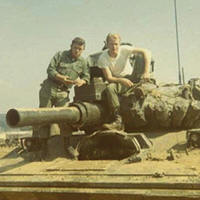 |
|
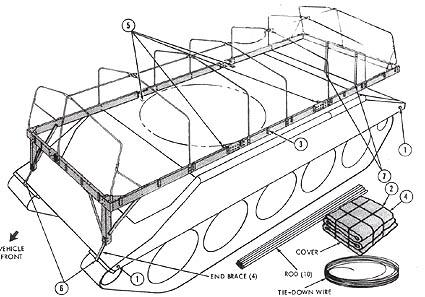 |
|
Gary Bell - 2/14 ACR gets the Sheridan |
|
As the
new Sheridans were handed off, the crews found them
enclosed in a tarp and bow configuration with the
associated equipment in a large wooden crate bolted
to a deck extension. Here, from the 1966 Sheridan
-12 TM, the diagram for the depot bow kit. |
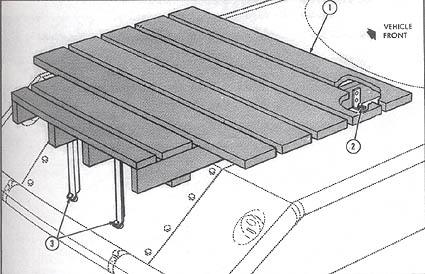 |
|
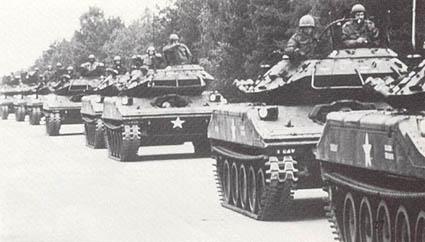 |
Same
manual, the deck extension. After in processing the
vehicle, the bow and extension kits were discarded.
--David C. Clarke |
|
A
Sheridan road march, probably after a POMCUS draw
from the mid 1970s. The image shows what new
Sheridans would have looked like as the crews first
took them out for road trials.
--US Army / Mesko |
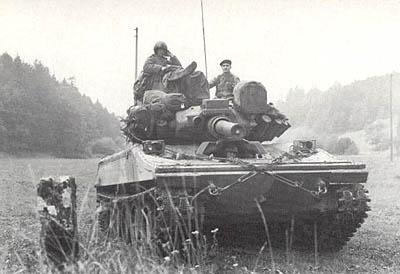 |
|
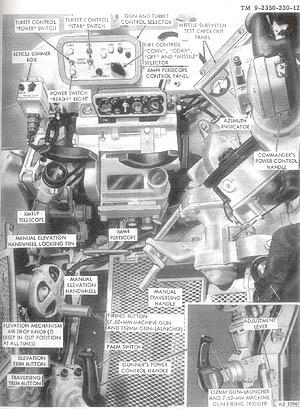 |
Mid
1970s image of a cavalry Sheridan on the border,
oddly with rail loading equipment attached to the
front. The rubber muzzle plug is clearly evident.
--US Army / Mesko |
|
-12 image of the gunner's position in the turret. By
M1 tank standards, not too complicated but for newly
trained troopers in 1970 coming from the M60A1 tank,
it was a daunting array of panels, switches,
adjustments and meters. Much of the interior of the
turret was covered with " little white boxes "
connected by cables, all part of the fire control
system and all subject to failure.
--David C. Clarke |
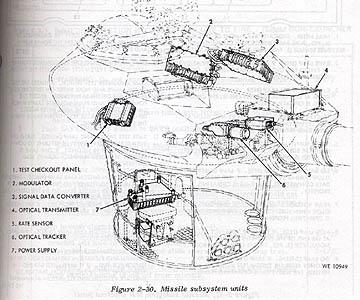 |
|
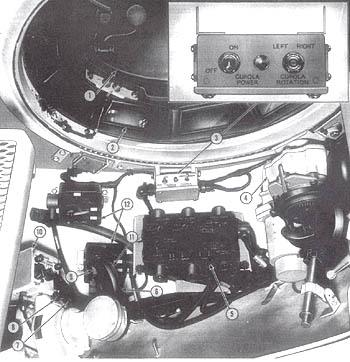 |
An
image of just the components associated with the
missile system.
--David C. Clarke |
|
Interior view of the TC's position in the turret
with a detail of the power control to the cupola.
--David C. Clarke |
 |
|
 |
The M2
machinegun fitted to the cupola with power traverse
controls. The left and right power traverse controls
can be seen immediately adjacent to the grips of the
M2. The control wiring runs from the bottom of the
machinegun forward towards the cradle.
--David C. Clarke |
|
Diagram
showing the missile alignment tracker kit necessary
to insure the sight and missile control optics were
properly aligned ... move the vehicle .... do the
test .... move the vehicle ... do the test.
--David C. Clarke |
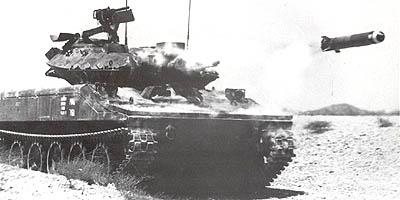 |
|
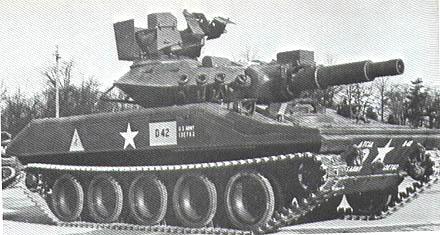 |
A
missile launch.
--Hunnicut |
|
This
image is from Fort Knox but it shows how an early
production model M551 as found in the 2/14 ACR in
1970 would have appeared. This Sheridan has the bore
evacuator sleeve on the barrel, indicating it is a
pre # 700 model, the missile tracker optics set is
in the box immediately over the gun barrel at the
mantel (the door is closed in the image), the set of
shields surrounding the TC's position is evident and
gives the turret the cluttered appearance that many
Sheridan crews recall.
--Stefanowicz |
| |
|
|
Prelude
In researching this piece, the trail goes cold for a key period, mid
1971 to mid 1972. During this year immediately prior to the re-flag of
the 14th ACR to the 11th ACR, there were important developments in the
Sheridan story. In Bad Kissingen and elsewhere, the M114s are turned
in and three more M551s were issued to each cavalry platoon. The
totals become six per platoon, eighteen per troop and fifty-four in
the squadron. SCO during this time, LTC (Ret) Tuggle had no interest
in helping tell the story, the few other members of his command we
have identified from this period felt similarly.
Other areas unexplored; we do not know initial reactions of the East
German Border Troops when the Sheridans were first seen along the
trace, the gunnery experiences beyond the first major density at GTA
that Terry Smith recalled or the performance of the vehicle in the
early 1970s on major maneuvers. There are hundreds of troopers out
there who lived these experiences, we have not found them, they have
not found us.
BG (Ret) Mike O'Connel, SCO at the time of the re-flag, had no clear
memory of the TO & E development or of his experiences with the M551
beyond the fact that the M114s were gone when he assumed command. It
seems safe to say that the Sheridan and the cavalry got along, as crew
and institutional knowledge increased, as more school trained
personnel came to Europe and the maintenance echelons all across 7th
Army learned the peculiarities of the vehicle, things improved
somewhat.
Elsewhere, the troubled MBT 70 program was killed, so much for joint
US-German cooperation in designing a new main battle tank to be
fielded NATO wide, and the M60A2, everything you could want in the
Sheridan and more ... pushed into a new turret and mated to the M60A1
hull, was finally fielded in both CONUS and USAREUR. Like the
Sheridan, too much money had been spent on the program to kill it.
Rather than replacing existing armor battalions and swapping tanks,
the A2s were added as whole new battalions to existing divisions, a
good idea in Germany where tank on tank combat was the essence of
battle planning. The more US tank battalions, the better everyone
felt.
LTC (Ret) Lee Allen:
"The Sheridan incorporated a number of new technologies and design
features that made it difficult to operate and maintain. Among these
were the use of steel and aluminum components; combustible casing
cannon ammunition and an electrical/mechanical gun/missile firing
system."
"The hull was aluminum similar to the type used on the M-113. Mounting
the engine and suspension systems to the vehicle required special
bolts and fittings to compensate for the difference in the two metals.
Special torque settings had to be maintained and once a little wiggle
room developed the connection point would deteriorate quickly. Good
crews were able to make it work."
"Keeping the vehicles running was a difficult task and required skill
and perseverance of a high order. I recall one alert as Squadron
Commander, in which the men of the 2nd Squadron were able to move
every vehicle, including the 52 Sheridans, out of Daley Barracks.
During Troop tests, in 1975 I believe, all three troops left with 18
running. E and G finished with 17 still running and F had 12, possibly
because of support they had given the other two troops while they were
on their tests. In contrast other troops of the regiment finished with
an average of 6 vehicles. This was a real tribute to the efforts of
those involved."
"Combustible casings were compensated for by the use of what appeared
to be fiberglass and asbestos holding bags that covered the casings as
the rounds sat in the ready rack. While with the 2nd Squadron in
Vietnam I had the opportunity to see a couple Sheridans hit by RPGs.
Once the combustible casings caught fire, which was almost
instantaneously if they were hit, the whole vehicle exploded and
burned. Because of the aluminum hull, the end result was a big puddle
of molten metal on the ground and the loss of the crew."
"The firing system was what seemed like an endless series of
electro/mechanical switches any one of which could shut down the whole
system. It was a terribly frustrating thing to have to trouble shoot
the system to locate some mechanism breaking the circuit. This was
especially true in Vietnam where the heat and humidity raised havoc
with the temperamental system. The ever ingenious troopers solved the
problem, if you can believe it, by running a piece of WD-1, commo
wire, from the electrical firing mechanism (firing pin, you might call
it) to the overhead dome light. When the tank commander gave the word
to fire, the loader would reach up and turn the dome light on. It
worked."
"In Germany after preparing for range firing I don't recall that we
had much trouble with the gun. Everything was clean and adjusted and
folks were very familiar with the system. Firing the missile was
another story."
"Because we didn't fire a missile very often and because the system
was complex and the missiles often old and not very reliable, we set
up a system on the range that greased the skids, so to speak. Before
going to the missile firing point the vehicles passed through an
ordnance platoon which gave them a thorough going over, tested the
systems and the missiles and then sent the vehicle directly to the
firing point. It worked pretty well and the crews got to see what it
took to get things in order."
"During my time we had one missile load up on the vehicles just to see
if we could do it. The missile were kept in storage and we ran the
vehicles empty with the intention to load up if things got hot. We had
been directed to turn in a large number of missiles for ordnance
inspection and testing. We got permission to unpack and load up on the
vehicles those that were going to be turned in. It was an interesting
experience, which we taped with a portable TV and later showed to the
other squadrons so they could see how it was done. A lot of bent
storage racks were found as well as some which were just plain
improperly fitted in the turret. It was good to get our hands on the
real thing just for the experience."
"As an example of a weapons system that didn't work very well and was
foisted on the troops without proper testing the Sheridan was without
peer. But in the hands of motivated, smart and determined cavalrymen
it was made to work."
Col (Ret) Clint Anker
"While I had worked with Sheridans at the basic course and in Vietnam,
it was not until I was assigned to 2nd Squadron, 11th ACR in Germany
that I really became intimately familiar with the Sheridan. I joined
the squadron in September 1974 as the Squadron Border Officer and in
May of 1975 I became the F Troop (Fox Troop) commander. It was here
that I really got deeply involved in all facets of the Sheridan, from
employment, to maintenance, to gunnery."
"The three ground cavalry troops of the squadron (all three squadrons
of the Regiment) were organized with three recon platoons. Each recon
platoon had one M106A1 4.2 inch mortar carrier, one M113A1 infantry
squad carrier, and six M551 Sheridans. So each troop has 18 Sheridans,
or a total of 54 in the squadron. All were in standard configuration,
with an M2 MG at the TC's station (protected by a commander's cupola-a
metal shield covering about 300 degrees around the TC, and a shield in
front of the M2 that provided coverage of the remaining arc) and an
M73/M73E1 or M219 7.62mm MG as a coax (the M73/M73E1 and M219 were all
variants of the same gun-and none of them worked well, a true piece of
junk)."
"While I was in the squadron there were two significant changes to the
above. We reorganized the recon platoons, replacing the infantry squad
with two scout squads. This added an additional M113A1 to each
platoon. These scout squads were also fielded with the Dragon medium
anti-tank guided missile. We also transitioned from the M551 to the
M551A1. The A1 version of the Sheridan differed from the M551 by the
addition of a laser range finder (LRF). This was, I believe, the first
laser rangefinder fielded by the Army. The fielding was done two ways.
About half of the squadron's Sheridans were simply swapped out for new
ones with the LRF. The other half were modified on at Daley Barracks.
A team showed up and did the machining and mounting for the LRF."
"The LRF was in the commander's station, and not part of the gunner's
control. Nor was it slaved to the gun in any fashion. The commander
would drop down to the eyepiece, push the lase button, and read the
resulting range to the gunner, who then put the appropriate range line
in the gunner's telescope on the target. These were not eye-safe
lasers. Before any gunnery density, we had to clear the downrange area
of any reflective material that might cause reflected laser energy to
become a danger to people up range. This danger became apparent to me
the first time we took the Sheridan to Wildflecken after conversion to
the A1 configuration. While sitting on the line waiting to shoot on
the first night table, I was lasing downrange to get the feel for the
LRF. You could easily see the pulse of red laser light going
downrange. While traversing and looking for targets at different
ranges, I happened to sight a bird sitting on some perch downrange.
When I tried to lase on the bird, the bird jumped when hit with the
laser and flew off. Not sure if this was just coincidence, I lased
several other birds, all with the same result."
"The Sheridan was an absolute nightmare from a maintenance standpoint.
There were three basic systems that required maintenance-the
suspension, the power train, and the turret. The suspension was by far
the best component of the system and the easiest to maintain. It was
rugged, reliable, and gave the system good cross country mobility. The
power train was pretty good, but had some weak points. The engine was
a Detroit Diesel supercharged 6V53T. 6V53T meant it was a 6 cylinder,
V block, each cylinder had 53 cubic inches, and it was turbocharged.
This was the same engine as the M113A1 with one change. The M113A1 was
supercharged (roots type blower), while the Sheridan was both
supercharged and turbocharged (exhaust gas driven turbocharger)."
"There were three weaknesses in the power train. First, it had a
tendency to overheat in certain circumstances. Second, the
transmission was not rated for the same horsepower as the engine. If
drivers abruptly applied full power from a standing start, it could
overstress the transmission and cause failure. The third problem
related to the engine governor. The governor limited top speed, and
consisted of a box mounted on top of the engine, with a control rod
that mounted on top of it. The problem with the governor was that it
was mounted in a position on the top of the engine were people
frequently stepped on it. When the grill doors were open, there was a
bar about six inches wide that ran down the center of the engine
compartment. This didn't provide enough footing for some of the
maintenance required. When looking for footing, people not
infrequently stepped on the governor. This often resulted in a cracked
top plate on the governor housing. When cracked it caused the governor
to either shut down the engine entirely, or to cause the engine to run
away and rev as fast as it would go."
"However, it was the turret that was the real problem. It was perhaps
the worst designed turret every fielded. It may have been the worst
designed system ever fielded by the US Army, period. To understand
this, you have to go back to the development of the system. The
shillelagh was developed independently of the Sheridan itself. The
shillelagh was an infra-red guided anti-armor missile. It was six
inches in diameter (roughly 152mm), stood about three feet high and
weighed 62 pounds. After it was designed, the Army was looked for a
platform to mount it on. The only armor system under development was
the armored reconnaissance/airborne assault vehicle (ARAAV). The ARAAV
was originally designed with a 76mm high velocity gun with an
automatic loader. Even though the design team told the Army they could
redesign the missile to fit the 105mm gun of the M60 tank (got this
from then Col. Ballantyne, RCO who had worked on the project), the
Army decided to fit the system to the ARAAV."
"There was a feeling that the system should not be totally reliant on
a missile, and that it needed a conventional cannon capability also.
Since the missile was 152mm, this meant the cannon round had to be
152mm also. With nothing in the inventory that fit this, a new round
was designed. It was also decided to make this a caseless round, with
no brass shell casing. This had the great advantage of not having hot
shell casings rolling around the turret floor during firing, but
created a number of serious problems. The simple one was how to store
the rounds in the turret without creating a danger of rounds igniting
by a spark (always a possibility in an electric turret). Each round
came out the ammo box with a rubber cover (elephant rubber) over the
powder train. The rounds were stored in the turret inside a reusable
asbestos bag that covered the powder train again."
"During development, it was determined that the caseless powder train
did not always burn completely when fired. When it didn't, it left
glowing powder remnants in the chamber. When the next round was
loaded, these glowing embers ignited the caseless powder of the
incoming round, usually before the breech was closed. This was
potentially fatal to the crew. To solve this problem, they created the
closed breech scavenging system (CBSS). The CBSS injected a blast of
high pressure air into the chamber after firing before the breech
opened, clearing out any remaining embers."
"The CBSS consisted of two major components-two high pressure air
bottles and a compressor that filled them. The bottles were fiberglass
wound bottles that could hold up to 3100 psi of compressed air. They
were inside the turret, just forward of the loader's seat. The
compressor was located under the loader's seat. Unfortunately, the
compressors were very unreliable. I say compressors, since there were
three different models used in the Sheridan, mixed with no apparent
system, so that the maintenance teams had to deal with all three
within a given troop. On average, only half of the compressors were
working at any one time. Each vehicle carried air hoses and those with
non-functioning compressors slaved off of a vehicle that did have a
working compressor."
"Of course, this meant that the receiving vehicle could only be
pressurized to around 1500 psi and could not keep the pressure up
during firing. A fully functioning system would engage the compressor
during firing and maintain the pressure in the bottles at a full 3100
psi."
"Another problem was the extractor. When the shillelagh was fired, it
left behind an aft cap. The aft cap was an aluminum casing that looked
like a short shell case. It was only about a foot high and contained
wires that transmitted power from the firing probe to the missile
motor. To eject it from the breech required an extractor, much like a
conventional shell casing in a regular breech. Unfortunately, if left
engaged when using the conventional round, when the round was not
fired and the breech opened, the extractor would rip open the case.
This would result in powder pellets being dumped on the turret floor.
To prevent this, the loader had to remember to disengage the extractor
when firing conventional rounds, and to engage it when firing the
shillelagh."
"To give the extractor an engaged/disengaged capability required that
it be accessible from outside the breech. Thus it was bolted on to the
breech on the loader's side. Since it penetrated all the way to the
inside of the breech, it was subjected to the full chamber pressure
when the conventional round was fired. Sometimes, this pressure would
sheer the bolts holding the extractor on the breech and launch the
extractor into the coax MG at high velocity, usually ripping the MG
off its mount. This was relatively rare, but did occur."
"The other impact of this extractor problem was that there was no
mechanical advantage to help remove an unfired conventional round from
the chamber. The act of chambering the round usually wedged the round
in the chamber fairly securely. If the round was not fired, or it
misfired, the only way to remove the round (remember, it had a
caseless powder train that provided no secure purchase to extract the
projectile) was to punch it out from the front of the gun tube. So
every time we went to gunnery, the bell rammer was assembled and
lashed to the outside of the vehicle along the loader's side. Any
stuck round required the loader to open the breech, dismount the
vehicle, unfasten the bell rammer, insert it down the gun tube, and
punch the round out (which the gunner had to catch inside the turret).
On the M60 series, all you had to do was drop the breech and the
round, aided by gravity, slid out easily."
"The next major problem associated with the gun itself was what was
called a rupture plug. In many armored vehicle cannon designs, the
recoil system was closed. If an overpressure situation occurred, it
blew the seals on the recoil system. This normally required the cannon
to be dismounted from the turret to replace the seals, a very high
level (usually depot) maintenance task. To alleviate this problem, the
Sheridan designed into the recoil system a rupture plug. The rupture
plug was a very large bolt (about an inch in diameter) that screwed
into the hydraulic fluid reservoir of the recoil system. The bolt was
hollow and there was a very precisely machined thickness of metal in
the bolt cap that was designed to "rupture" at a specified pressure.
When an overpressure situation developed in the recoil system, it
caused the cap to rupture, releasing pressure and saving the recoil
system seals. To fix the problem, all that was needed was to unscrew
the rupture plug, screw in a new one, and fill the recoil system
hydraulic reservoir. Great theory-poor execution."
"For whatever reason, the recoil system caused these plugs to rupture
far more often than the M60 tank recoil system ever had problems. The
entire time I was in Fox Troop, and later as the squadron motor
officer, I never heard of an M60 that blew its recoil seals, but I had
a rupture plug blow on my Sheridan at each of the four gunnery
densities I fired as a troop commander. When the plug did blow, it
released hot cheery juice (hydraulic fluid) in a fine mist that
completely soaked the crew."
"But that was not all that was wrong with the gun design. The breech
was an interrupted screw thread breech. It had a motor that unscrewed
the breech after firing, backed it out of the chamber, and then rolled
it to the right to open the chamber so the next round could be
inserted. But, like many systems in the turret, it was electrically
driven and power frequently failed. On the end of the breech was a
small lever with a round knob handle. At the end of the handle,
attached to the breech, was a key that could be pushed in to engaged
the handle to the drive shaft that controlled the breech locking and
unlocking. When the key was engaged, the loader could manually open
and close the breech."
"Because the conventional round was caseless, it did not have a shell
casing to obdurate the breech during firing. The interupputed screw
thread didn't provide close enough tolerances to seal the breech, so
some other sealing was needed. The solution was to use an obturator
seal. The obturator seal was another finely machined piece of metal.
In this case, it was a circular piece, the diameter of the breech,
that press fitted into the breech and sealed the gap between the
chamber itself and the breech. When in place it worked fine. But it
was only a press fit and sometimes came loose when the breech was
opened. To prevent this, the usual solution was to coat the obturator
seal with peanut butter (I'm not making this up), press it into the
breech, and then, when the gun was fired, the burnt peanut butter
essentially acted as a glue that held the seal in place for subsequent
firings."
"The final problem with the gun itself was the firing probe. Unlike
percussion systems, where a firing pin actually struck a primer to
ignite the powder train, the Sheridan had an electric firing system.
The rear of the conventional round had a primer that was electrically
initiated. It had metal "petals" on the primer. The firing probe at
the base of the breech had a metal protrusion, about half an inch
long, that penetrated the petals and made the electrical connection.
When the firing circuit was energized, electricity flowed to the
firing probe and then to the primer through the metal petals. The
system was designed to operate at 110 volts AC. As will be explained
later, the system often defaulted to 24 volts DC. And 24 volts DC was
enough power to initiate firing, if everything was clean. But
remember, this was caseless ammunition with no case to shield the
chamber from firing residue. Every time a round was fired, some carbon
was deposited on the chamber walls and the breech. It only took 2-4
rounds before the buildup of carbon on the firing probe was sufficient
to cause a misfire, when the system was operating on 24 volts DC. At
110 volts AC the system would work through much more carbon fouling,
but almost all of the systems were 24 volts DC. This was a real
problem."
"The first time I went to gunnery, at Wildflecken, in the summer of
1975, at the end of the first day the troop had a butt full of misfired
rounds. I'd not run into this problem before. At the meeting with
platoon leaders and platoon sergeants that evening, I asked why we had
so many misfires. PSG Stiggers, platoon sergeant for 1st platoon said
it was because the loaders were not cleaning the firing probe. This
was the first time I'd hear of this and asked him to explain. He said
that the probes got dirty during firing and had to be cleaned after
each round to ensure reliable ignition. I asked how this was done and
he said ' Why using a scouring pad from the messhall, everybody knows
that.' I was a bit upset at this point and allowed as how, obviously,
not everyone knew this or we wouldn't have a put full of misfires.
This was how I learned about this procedure. It required the loader to
have a green scouring pad handy and, after every round, he reached
into the breech with the pad and wiped off the firing probe. Once the
word got out to everyone, the problem of misfires went away."
"Now, put this all together and the loading sequence for the poor
loader would frequently look like this. Round fires (hopefully, if not
see procedure above for removing stuck round). Loader engages the key
in the breech drive to unlock the breech (if the electric motor was
inop-but you couldn't leave the key engaged if the electric motor was
working, or the spinning lever could break your arm-it wasn't all that
long, but the turret was crowded) and rotates the lever vigorously
many, many revolutions because the manual lever had very low
mechanical advantage. He then takes the green scouring pad and wipes
the firing probe (a foot inside breech). Next he checks to ensure the
obturator seal is still in place. He picks up the round, removes the
asbestos bag, rips the elephant rubber off the round, loads the round,
and vigorously rotates the lever to close the breech."
"The last part of the turret was the electrics. Unlike the turret on
the M60, which was mostly hydraulic (traverse and elevation),
everything in the Sheridan was electric, except the recoil system. The
missile firing system consisted of seven white boxes that contained
various parts of the firing system, to include the guidance system for
the missile itself. There were other boxes in the turret, most notably
the accessory box and the power amplifier. Most of this system was
designed to fire the missile, and adapted to firing the main gun's
conventional round. But the designers of the electronics never
intended these electronics to withstand the recoil generated by a
152mm cannon firing on a 17 ton chassis. This recoil wreaked havoc on
the electronics, especially the accessory box and the power amplifier.
The amplifier was the box that changed the 24 volt DC power to 110 AC.
This was a very unreliable box. So much so, that there was an
authorized modification work order (MWO) to bypass the box completely.
This consisted of shunting input and output, thereby bypassing the
internal electronics."
"Almost every Sheridan had this MWO applied. The "accessory box" had
10 circuit boards inside, A1 through A10. These circuit boards
controlled various subsystems of the turret. A1 was the main gun
firing circuit and A5 was the coax firing circuit. For some reason,
the A1 card burned out frequently. The solution was to replace it with
the A5 board, which was identical. When the A5 board was used in the
A1 slot, it meant that the coax could not be fired by the gunner, but
had to be fired by the loader. When the coax was directed by the TC,
and the gunner said "on the way", the loader leaned on the trigger of
the coax (assuming it would fire at all, which was not always the case
with the M73/219). I had one Sheridan that had a loose lid on the
accessory box. Every time the main gun fired it would cause the main
gun circuit board to jump out of its slot. So, on this vehicle, part
of the loaders task included pushing the circuit board in, in addition
to everything he had to do (see above)."
"I had a turret mechanic who figured out that he could solder fried
circuit boards (replacements were always in short supply) and make
them work. He submitted this idea through the Army suggestion program,
but was told it wouldn't be pursued because they (the Army maintenance
system) couldn't guarantee quality control. So a simple, cheap
solution was turned down by some bureaucrat who didn't have to fight
the system. We continued to solder our own."
"The other impact of recoil on the system was that it threw the
calibration of the missile system off. The missile system required
precise alignment to ensure hits. This required our supporting
ordnance detachment, plus higher level technicians, to adjust the
system each time we went to gunnery if we were going to fire the
missiles. In fact the normal routine at each gunnery was to set up a
calibration line with all of the tests on the Table VIII range (Table
VIII was the individual crew qualification table, the only one where
we fired actual missiles. We fired two missiles per vehicle each
year). Just before firing, each vehicle ran through the entire missile
calibration routine. The table was set up so that we always fired the
two missile engagements first, before we fired any conventional main
gun rounds. This was done because firing the conventional rounds
frequently knocked the missile system out of calibration and no one
wanted to waste a very expensive missile due to calibration problems.
Of course, this begged the issue of how we would fight the Sheridan in
actual combat where we wouldn't have the opportunity to run the
calibration prior to the fight, and where we couldn't always fire all
our missiles (each vehicle could hold eight shillelaghs in the turret)
before conventional rounds were fired."
"The last issue in the turret was the coax machinegun. As already
mentioned, it was very unreliable. The first version was the M73, then
it was modified as the M73E1, then the M219. The M219 was not a
different gun, but substantially the same as the M73 series. We had a
mix of all three guns at any one time. The coax was very complex and
very expensive. I was told that it cost about $5000 apiece, at a time
when the M60 MG cost about $1200 apiece. The barrel mounted in a
barrel jacket, which in turn was bolted into the coax tunnel in the
turret. The barrel jacket contained a pair of holes into which the
receiver of the MG was attached using two pins that were retracted
using circular handles that resembled pins to hand grenades. The
attachment did not provide a consistent, tight fit. It allowed the
receiver to move on the barrel jacket, which in turn meant that rounds
often jammed during feeding. Some crews resorted to taking pieces of
coke cans that had been flattened and using these as shims to hold the
receiver in the same position during firing. Overall, we had about 50%
of the coaxes that worked, and those that worked were rotated among
vehicles during tables that required coax engagements. Again, not a
solution that would work in the GDP."
"The other two relatively high tech systems on the Sheridan was a
stabilized gun system and the XM44 gunners sight. The XM44 was an
image intensification sight for the main gun. The fact that it was the
XM44 meant that it was not type classified and still considered
developmental. It was notoriously unreliable. The stabilization system
was not very robust, and only worked on fairly level ground. Even
then, the sight picture jiggled quite a bit and while it was much
better than nothing, it was not very useful going cross country. On a
range road it might allow on the move firing, but only on a flat
road."
"All of this resulted in a very unreliable system. During two gunnery
densities in 1976 I kept detailed records of turret failures that
required attention by someone outside the crew (troop or squadron
turret mechanics, or ordnance detachment mechanics). Over the two
firing densities, the average for the entire troop was that vehicles
required outside attention an average of every 25 rounds fired. This
meant that, on average, a vehicle would require outside maintenance of
the turret for every basic load it fired (the basic load was 25
conventional main gun rounds-usually HEAT-MP)."
"In January of 1977 I became Squadron Motor Officer for 2/11 ACR. Now
I had to worry about all 54 Sheridans in the squadron. Fortunately, I
had two marvelous warrant officers to work with. Chief Warrant Officer
3 George Freisheim was the Squadron Maintenance Officer. Chief Warrant
Officer 4 Bill Wilson was the commander of the Ordnance Detachment
that supported the Squadron. The two were worth their weight in gold.
Chief Freisheim was both a wealth of knowledge and had worked out a
system to ensure high readiness rates for a notoriously unreliable
system. Chief Wilson was a very senior warrant officer who seemed to
know everyone in Europe in the maintenance business and could get
anything he needed (or the squadron needed) if he wanted to."
"The reality was that it was impossible to maintain an acceptable
readiness rate (C-1 on the Unit Status Report) if one followed the
normal procedures for maintenance. The normal process was based on a
prescribed load list (PLL) that was based on historical usage. A
certain stock was retained on hand based on past demands. The problems
were two fold. First, the repair parts system was not responsive
enough to provide repair parts in the quantities required in the time
required to maintain C-1. Second, we were not allowed to keep certain
parts on hand because they were not repair parts, but were 'major
assemblies.' The later included the XM44, the gunners telescope, and
some other components. All of this was compounded by two other
factors."
"First, some critical parts were in short supply and thus couldn't
meet demand based PLL requirements. Second, during firing densities,
the rate of breakage far exceeded the capacity of the system to
respond. And yet, we (and other squadrons in Germany) managed to
maintain a legitimate C-1 readiness rate, even during gunnery. This
was done through a combination of working outside the normal system
and a network of squadrons that shared parts. It was simply impossible
to work with the normal PLL stockage."
"The result was that the squadron maintained a huge inventory of
"excess" and "unauthorized" parts-most of which were turret parts. We
had a turret trailer and a conex full of these parts. We had excess
XM44 gunner's sights, excess gunner's telescopes, various white boxes
(accessory, guidance, power amplifiers, etc.) and many, many other
hard to get parts. Every time we had an Annual General Inspection we
moved the trailer and the conex into the area of the artillery
battalion on Daley Barracks. Discovery of these excess parts by the
inspection team would have caused major problems."
"The other solution we had was an informal network of squadrons that
shared parts freely. We had about four or five other squadrons we
worked with. One was in the regiment, one in 2 ACR, and the rest were
divisional squadrons. The rules were simple. If you called one of
these squadrons for a part, and they had it, unless they had a vehicle
on deadline for that part, they sent it to you. The only exception was
if the unit was headed to gunnery within a week, then they kept their
excess. When one of the squadrons went to gunnery, the others provided
turret parts to support them. Thus, when we went to gunnery, we took
not only our excess, but some of the high demand, critical items from
our ' partners.'"
"One of the items that was a perennial problem was the halon fire
extinguisher. The Sheridan had a high pressure halon bottle in the
turret to put out fires. If this was inoperable, the system was
deadlined. The bottle had to be removed at each quarterly service and
weighed to ensure it was fully charged. This was tricky because when
disconnected from the vehicle it still had a lever that tripped the
discharge nozzle. It was not difficult to bump this and set the bottle
off. If this happened, the bottle became a rocket that could fly
around and do considerable damage. To prevent this, it was possible to
put a finely machined screw cap on the bottle when it was removed from
the vehicle. Unfortunately, these caps were scarce (we generally had
only one or two in squadron maintenance). Fire extinguishers were a
constant shortage and no one had much excess to cover this, so we were
exceptionally careful with these during Q services."
"I was Staff Duty Officer one weekend when I got a call from a warrant
officer in 3rd Infantry Division on Sunday morning as I was about to
go off duty. He asked for Chief Freisheim's phone number. I said I was
George's motor officer and could I help him. He told me that he wanted
George to come down and see him as he had some "parts" for him. When I
called George he said this guy was a good friend and if he said it was
worthwhile, it was. So George and I went down that afternoon to visit
and see what he had. It turned out that he was a direct support tech
supply officer with a warehouse full of parts. The unit was
transitioning from DS to GS (general support) and he had to turn in
all of his parts and draw a new set. Rather than turn it in, he was
essentially giving it away. All we had to do was pick it up and make
sure we identified the parts on his slack deck (computer punch cards).
For the next two weeks we sent five ton trucks down to the warehouse
to pick up parts. As part of this we picked up a huge number of
Sheridan parts, to include wiring harnesses, obturator seals, and 16
complete fire extinguisher kits. These kits included bottles, wiring
harnesses, and the scarce screw caps. During a subsequent AGI I found
out that these kits were the entire USAREUR inventory which had been
lost in transit. We turned some of them back in, but kept enough to be
healthy for some time."
"Overall, the Sheridan was a mess. It was unreliable in the extreme
and dangerous to the crew (turret fires were not uncommon and it was
lightly armored-when hit it tended to burn to the ground in a pool of
molten aluminum). It was a great day for the Blackhorse when the
Sheridan was replaced with a true tank."
Robert A Stefanowicz
Fort Knox
"I was in the last Armor Officer Basic Course at Knox to feature
training on the M551 as a regular part of the curriculum. Starting
with the first new group of Lts arriving at Knox in January 1978,
training on the Sheridan would be conducted only for those very few
officers reporting to the 82nd Airborne. The M551 program was being
cut back severely to reflect the direction the Army was going with the
vehicle. I do not recall any of the staff stating exactly when the
Sheridan would come out of inventory in Germany, just that the
decision had been made."
"At Knox, training on the Sheridan lasted perhaps three or four days,
split between the turret trainers and classroom instruction for
Conduct of Fire and a basic familiarization with the equipment. A day
of mechanical operation followed to include driving for a few hundred
meters and then a tactical problem, perhaps another ½ day of driving /
experience in the turret. We were always shepherded by members of the
Armor School support battalion, (2/6 Cav ?), they tried to answer
questions and pass on their experiences, particularly if you told the
AI that you were pin pointed to a cav unit. I think we fired a round
or two in day light and were fogged off the night range. As both the
TC and the gunner, the round was very difficult to sense. The massive
recoil rocked the tank, there was always a cloud of dust kicked and a
wave of heat obscuration from the gun tube ... very difficult to track
the tracer and determine with any accuracy, the strike of the round. I
recall the Assistant Instructor loaded, he noted that it really was
too dangerous to be around the electric breech and ammunition based on
only a few hours of training."
Bad Kissingen
"Assigned to H Company in the Spring of 78, my recollections of the
last days of the Sheridan with the Eaglehorse are limited to being an
active observer and then participant in the training program to ready
the tankers of the scout Troops to receive their new M60A1 rise/
passive tanks at a home station hand off. Six Sheridans per Troop had
been placed into administrative storage, they were herded together as
a group, locked and secured. Apparently, as the M551 program was
ending, to ease maintenance and staffing concerns, this had been a
Blackhorse policy. Anyone looking to harvest parts would do so at
extreme peril."
"As Squadron Staff Duty Officer one night, the Sergeant of the Guard
was SSG Pharris of Troop G. I was interested in his experiences with
the Sheridan, he had been the top gun in the unit during the 1977 TCQC
at GTA. As the night wore on, we ended up with the-10 TM, the Sheridan
Gunnery Manual and any number of drawings made on scraps of paper
spread across the desk. While I have lost much of the technical
detail, I recall his enthusiasm and faith in the tank."
"From the conversation, I recall three things in specific; the M551
could be fairly trustworthy if you had an absolutely dedicated crew.
There was no room for error and the TC had to consistently train and
check what the gunner, loader and driver were doing. Things only
worked if you followed the manuals to the letter and Pharris felt he
had a great crew. He also believed that with the six tank set, the
only way around the turret problems and the missile issues were to
have four M551s only fire the main gun in the event of war and the
other two Sheridans would only fire the missile. That way, as missile
components failed, your could scavenge within the platoon, you could
arrange your gunners based on who did what best and the requirement of
constantly checking the missile alignment system was reduced to 1/3 of
the platoon. His last point that I remember related to using the
standard gunner's reticle to engage a moving target coming toward you
at an angle.
' Now that gunner has this complicated reticle based on range lines,
ammunition type, aiming points, lead lines based on estimated speed
... it all was set up for a shot at a 90 degree angle. When you add in
the target is coming towards you but at an angle, the gunner is really
on his own as to where to place the aiming point. It's all explained
in the manual but, damn, who can remember all those steps in combat?!
But my gunner could 'cause he's got PFM ... pure f******g magic!'"
"As the plan to replace the Sheridans was published, H Company was
heavily tasked to provide home station training for the Eaglehorse
Sheridan personnel. I recall the training was done Troop by Troop, on
a staggered rotational basis. It included familiarization and
mechanical training on the hard stand, class room training and then
driver and gunner training in the LTA. The program of instruction came
from the squadron S3 shop and was based on the emerging Skill
Qualification Training system for 19E personnel. For some of the 19G
crewmen, it was a difficult transition, particularly the skills
required to lay the gun to the target and then get to the range finder
and range to the target. Also, it seemed as though the cavalry Troops
had priority for arriving 19E NCOs to insure that each unit also had
at least a few experienced tankers."
"Training in the LTA consisted of a TCQC course set up in the valley
that ran the length of the area, perhaps five of six mock engagements,
none at a range beyond 1200 meters because of the limited size of the
area. The H Co NCOs, hooked in their CVCs to a split harness allowing
them to monitor and instruct the crews and then held on for dear life
to the turret-bustle rack as the tanks went through the course. At the
end of the training day, they would debrief and then dismiss the cav
Troop tankers and then howl over what they had seen. But, having said
this, progress occurred and using the 19E Skill Manual as the training
guide, good progress was made."
"The actual tank exchange was done on one of those rare hot late
Spring days in Germany. A DS unit from Hanau or Frankfurt was to
receive the Sheridans and it was a very forgiving program. Basically,
the M551 needed to move to the Bad Kissingen Bahnhoff under its own
power to be accepted. The vast quantities of special tools, ground hop
kits, diagnostic equipment and hidden spare parts were loaded into the
turrets and off they marched, one Troop at a time. Word filtered back
to Daley that some consternation occurred when an M551 got to the rail
head but couldn't limp on to the flat car ... would the DS unit accept
that tank? Apparently, the answer was yes, it was to everyone's
interest to get through the day and by 17 00, the only tanks remaining
at Daley Barracks were the 17 M60A1s of HAWG Company."
"A guard force was configured to remain by the loaded train and it
departed early the following morning. (that was a photo missed !) An
hour later, the second train arrived, thirty-six new (or
re-manufactured) M60A1s. The tanks were road marched back to Daley,
older German citizens of BK probably moaned that the cavalry had gone
back to only the big tanks that made big noise. Later that day, an
around the clock consolidated painting program began to get the new
arrivals into the proper scheme and within a week we were at WTA.
Months later, as Squadron Motor Officer, I was still running a weekly
truck to Frankfurt to hand off Sheridan parts and equipment that kept
rolling out of CONEXs, lockers and maintenance trucks. The Eaglehorse
would not see the Sheridan again for fifteen years."
| |
|
|
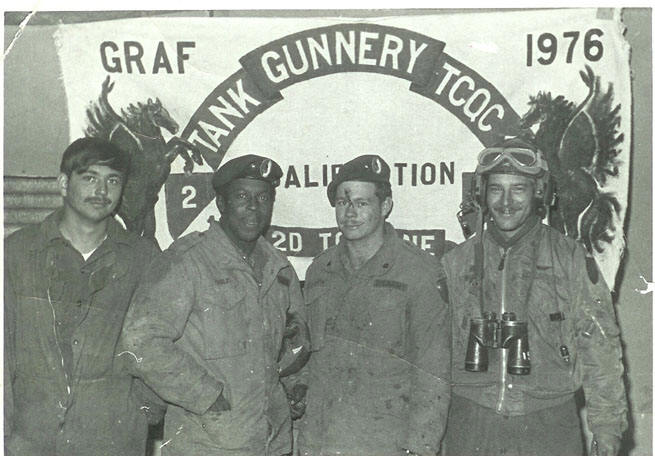 |
|
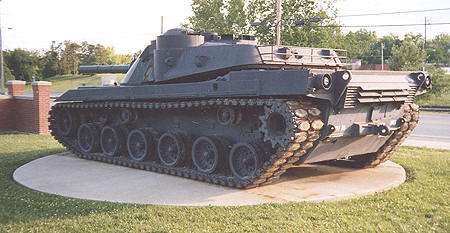 |
Just another day at Graf for SSG Pharris and crew,
proud and happy after qualifying their Sheridan.
With a dedicated crew, all things were possible.
--Robert Digerness |
|
MBT 70 on display at Fort Knox, one of six built in
the joint German - American tank development
program. The vehicle featured a crew of three, an
auto loader and a somewhat modified version of the
same gun - launcher system as found in the Sheridan.
GM was the lead US firm involved, typical of the
project, agreement could not be reaches as to
whether the nuts and bolts should be standard or
metric size.
--Gamma |
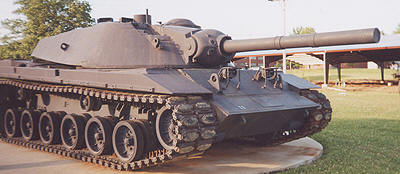 |
|
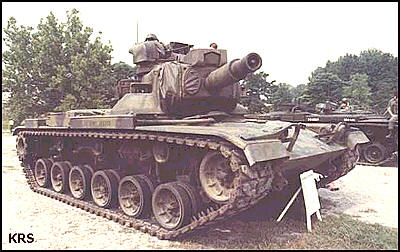 |
View of another of the developmental models,
Congress killed it with the costs out of control.
The Germans applied much of what they learned from
the project to Leo 1 and 2.
--Gamma |
|
M60A2 featuring the gun - launcher in a redesigned
turret and mated to the M60A1 hull. Much of what
worked well in terms of fire control with M1 was
tried with the A2 ... with marginal results. Tank
trivia for beers: first US tank with factory
installed laser range finder, A2. First US tank with
laser range finder, M551A1, after they were retro
fitted in the field.
--Gamma |
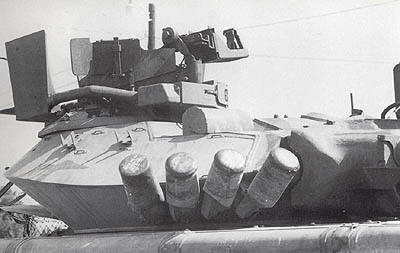 |
|
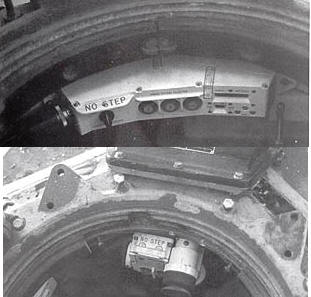 |
Seen from the front, the add on laser range finder
for the M551 is the box structure immediately
beneath the M2 machinegun mount. The TC would slew
the cupola to the target, range and then read and
announce the range return from a control box to the
gunner through the intercom. The gunner would then
match the range line on his primary sight to the
target, take his final aiming point and fire.
--Hunnicut |
|
Just inside the turret at the TC position, at left,
part of the range finder to include the window where
the distance return would appear as a digital
readout and on right, the laser range finder sight
that the TC would look through.
--Hunnicut |
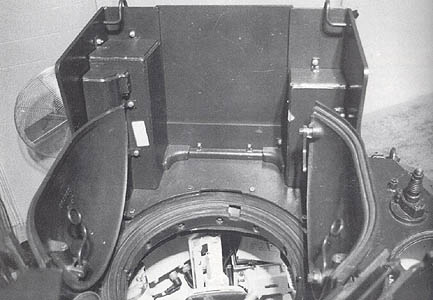 |
|
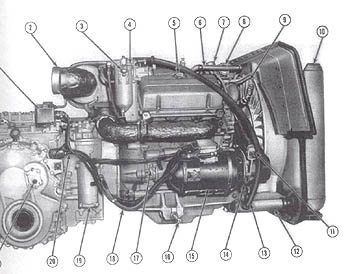 |
The system was added in the field to the Sheridan
fleet. Since no additional room existed in the
turret for the range finder components, the power
and modulator elements (( the box shaped structures
to the left and right of TC hatch )) were tacked on
to the interior space of the TC ballistic shield
system on top of the turret.
--Hunnicut |
|
Sheridan power pack from - 12 TM; transmission and
final drives at left with cooling radiator at far
right.
--David C. Clarke |
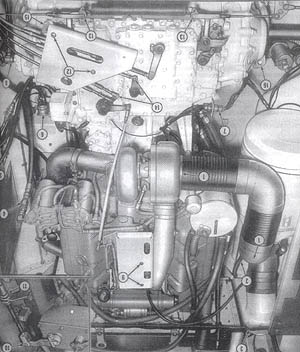 |
|
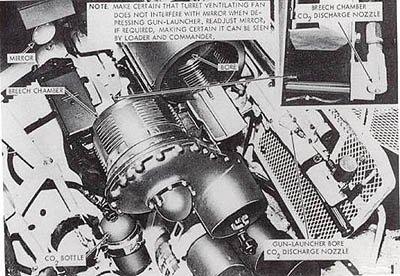 |
Engine as seen from the top with transmission at top
of image. Turbo charger in center of image and " no
step " plate that covered the engine governor is the
white rectangle below turbo.
--David C. Clarke |
|
The very complicated breech system of the gun -
launcher. View is from the loader's position, the
cannon is ready to load.
--Hunnicut |
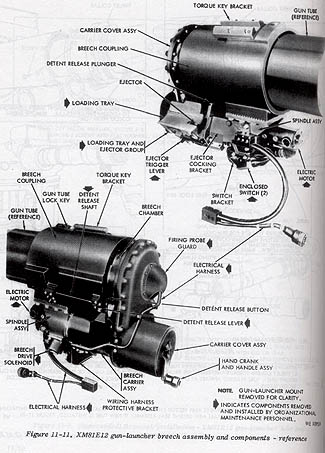 |
|
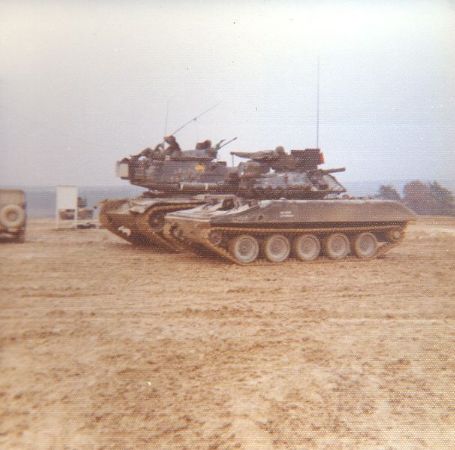 |
View of the breech from the-12.
--David C. Clarke |
|
Big mother & little Bro
--Rob Hudgins |
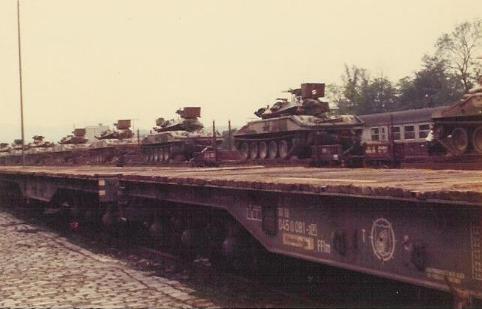 |
|
 |
Rail for Graf
--Don Mowry |
|
Sheridan in the field
--Don Mowry |
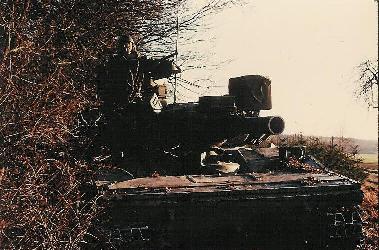 |
|
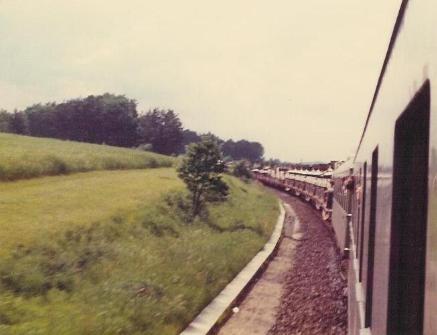 |
Me in the field
--Don Mowry |
|
Train moving to Graf
--Don Mowry |
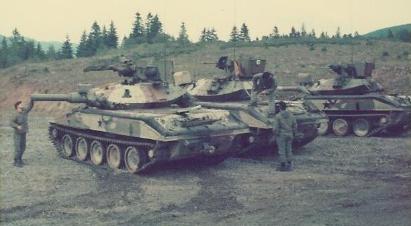 |
|
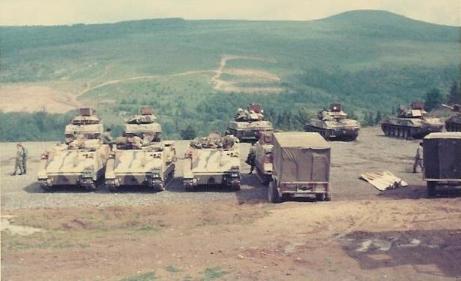 |
On the range
--Don Mowry |
|
Sheridans on the range
--Don Mowry |
 |
|
 |
FTX
--Don Mowry |
|
Troop G Sheridan at GTA.
--anonymous |
 |
|
 |
This is a picture of my crew, the "Fireball
Express". We had just come off of the line after
qualifying Distinguished. This is a rare photo, as
it shows the late SSG Hale (at far left, wearing the
sunglasses).
--John Skirmont |
|
Another great view of the night fire line as a
Sheridan cuts loose.
--John Skirmont |
 |
|
 |
M551 crewmen uploading their Sheridan in preparation
for a qualifying run. Notice the mud. The conditions
could by hot and dusty one day, wet and miserable
the next.
--John Skirmont |
|
Sheridans night firing from a stationary position on
the firing line. The driver didn't have much to do
here, and sometimes even caught up on some much
needed sleep. Yes, we drivers did actually get used
to the recoil enough to snooze!
--John Skirmont |
 |
|
 |
Nice picture of six Sheridans firing at one time.
--John Skirmont |
|
Picture shows how a TPT (Target, Practice, Tracer)
round was packed in the metal shipping containers.
Notice the rubber boot around the rear of the round.
Because M551 rounds were fired using an electrical
charge in the breach instead of a conventional
firing pin, this rubber boot prevented static
electricity from igniting the round. The pointed end
of the "big blue" is in the foreground, covered by
part of the shipping material.
--John Skirmont |
 |
|
 |
I
was lucky enough to catch this Sheridan firing while
on the move. Being a former Sheridan driver myself,
I can tell you that there is a great deal of
coordination required between the driver and gunner,
as it was imperative that the driver keep the track
moving very smooth and steady less the gunner miss
the shot. Another very interesting thing about this
photo is that the M551 is firing over the side. We
tried to avoid this practice, as turret screens came
loose and even cupola bolts sheared off as a result
of the massive recoil.
--John Skirmont |
|
Maintenance didn't stop if you were away from Daley
Barracks. This picture shows me (foreground) and a
member of my crew cleaning the pack (engine) and
engine compartment of our Sheridan while on a border
tour.
--John Skirmont |
 |
|
 |
Getting ready to pull the pack during maintenance
week, otherwise known as Q-Service (Quarterly
Service). This was normally done while we were back
at the barracks, between border tours and field
exercises.
--John Skirmont |
|
View from the drivers compartment of a Sheridan
while on a roadmarch. I can still smell the diesel
fumes when I look at this picture!
--John Skirmont |
 |
|
 |
Sheridans secured on the hardstand. Remember the
tarps?
--John Skirmont |
|
A
Sheridan and an M60A1 loaded on a train in
preparation for an upcoming gunnery. Due to the
heavier weight of the M60A1, only one was allowed
per railcar. Two Sheridans could be loaded on one
car, however.
--John Skirmont |
 |
|
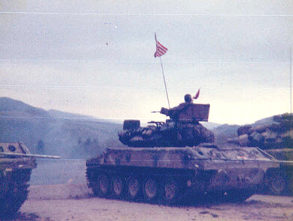 |
M551A1's conduct tank crew training at the LTA. I
recall this location, we also used it in H Co.
Across a small valley in front of the tanks, perhaps
1 kilometer away, was one of the new Bad Kissingen
multi - million dollar Kur and resort hotels. The
tank target ID and ranging course ran down the slope
and along the valley.
Thompson // Stefanowcz |
|
My crew on the firing line, WTA, 77.
--Dan Thompson |
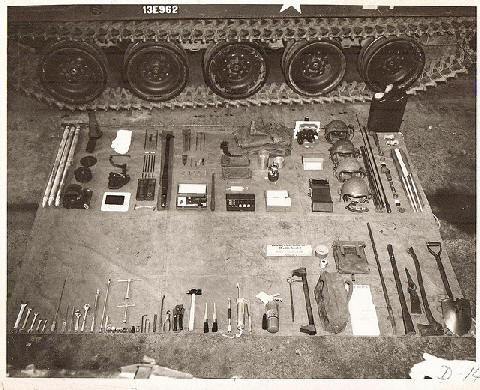 |
|
 |
BII layout for the M551
--Paul Janides |
|
The Sheridans were exchanged for M60A1 r/p ' s at
the BK Bahnhof in the early Summer of 78. A brand
new E Troop tank waits to fit on to the Camp Lee
hardstand.
--Dan Thompson |
|
|
|
|
| |
|
|
Through 1978 and into the following
year, the M551A1 Sheridan was washed out of the active Army
inventory with the exception of two micro fleets. The 4th Battalion
of the 68th Armor, part of the 82nd Airborne Division at Fort Bragg
retained their Sheridans and a group of 200 vehicles was allocated
to the new National Training Center for conversion into the Opposing
Forces mock up armored battalions. As the regimental and divisional
cavalry squadrons loaded out their M551s, they were replaced first
by the trusty M60A1 rise/passive and then, the M60A3. All of this
was viewed as small side steps in force development, the real
changes were just a few years away with the M1 tank in initial
production and M2 infantry fighting vehicle and M3 cavalry vehicle
only a year or two further away. What had once been a major armor
program was shrunk to a few hundred specialty vehicles.
The Sheridans went away, but where
did they go? Hunnicutt states that the majority of the fleet went
into storage, probably at Anniston Army Depot. This facility was
tasked with mechanical support of the fleet with GM Tank Plant in
Cleveland almost closed. Red River Depot, Texas may have also
provided parking space. Some portion of the fleet was probably
allocated to the National Guard, probably sparking no end of "good
news -- bad news" jokes in units across the country. This is not to
say, however, that the manufacturing base allowed the Sheridan to
pass silently from the scene.
Even as the Army was looking to the
future, GM and other defense contractors proposed a dizzying number
of M551 platform variations. By the late 1970s, the mechanical and
power train problems had been largely identified and fixed. The
micro fleet was upgraded though a Product Improvement Program and
the automotive system became the very reliable performer the
designers had first envisioned. Everything from a mortar carrier to
light weight infantry carrier to air defense weapons platform to a
recovery vehicle and a host of other variations was proposed to
anyone who would listen. In Washington, there we no takers beyond
some scant funding to experiment with the hull as a carrier in one
of the many high velocity cannon programs.
Even the troublesome turret was
addressed. The 152mm cannon with combustible case ammunition and
missile was tweaked, thermal sights eventually were added and the
tankers of the 82nd Airborne recall the Sheridan as a reliable
performer that gave their division the only tank on tank combat
capability that was readily air transportable and at immediate hand.
For all the "dune buggy with TOE missile" experiments, up armored 2
½ ton trucks and other depot fabricated designs, there was something
comforting about a tank, even if it was the M551. Also of note, both
General ( Ret) Wesley Clark and Lieutenant General Recardo S.
Sanchez both can claim service with the Sheridan tank and the 4 -
68th Armor.
Later redesignated as the 3 - 73
Armor, the battalion was in the lead waves of US action in both
Panama and the first Gulf War. Bobby Haig recalls his Sheridan
experience at Fort Bragg.
AIRBORNE ARMOR
"The Sheridan had a rocky start
with the Army and I believe this is the reason the Sheridan never
got the respect it deserved while serving with the 3rd
Battalion "Airborne" 73rd Armor Regiment, Fort Bragg,
North Carolina. Anytime a new tank is delivered to the military you
must have time to train and work on it to let the crew get familiar
with it inside and out. Combat is not the place to "test" unproven
equipment! When I arrived at Fort Bragg in 1988 there were all these
stories of how the Sheridan was too old … too small … too light …
not enough firepower … breaks down too much … there just isn’t a
place for the Sheridan in modern time conflicts. There was always
talk about replacing the Sheridan. They even had two contenders come
in and go head-to-head with the Sheridan so the "brass" could
evaluate it in person. The Sheridan went up against the Close Combat
Vehicle Light and the Light Armored Vehicle (LAV) 25 on a mobility
course setup at St. Mere Eglise Drop Zone at Fort Bragg. The
Sheridan breezed through a course of water, logs, barbed wire and
concertina wire. To the surprise of all, it then turned and
flattened an old truck at the end of the course, bringing cheers
from the generals, colonels and all who saw this magnificent
performance. The Sheridan never got replaced, but my old battalion
was disbanded in 1997."
"While we had them, however, you
could maneuver the Sheridan to your advantage in tight areas such as
the woods (not the jungle) or urban areas. With a small gun tube the
Sheridan could swing it’s turret around in very tight spots, as
other tanks would hit trees or buildings. The Sheridan was small and
fast enough to maneuver around the OPFOR (opposition force) and
score a "kill" during training. It also proved to be the extra
"punch" the Infantry of the 82nd Airborne Division had at
their disposal."
"Charlie Company, 3rd
Battalion "Airborne" 73rd Armor Regiment became the first
unit to airdrop Armor into combat during Operation Just Cause when
eight tanks parachuted into Torrijos-Tocumen International airport,
Panama in 1989. The Sheridan could be loaded and airlifted / air
dropped from a C-130, C-140, and the C-5 (the C-17 was after my
time). Its size and firepower was quite a tool for the 82nd
Airborne. From Fort Bragg to anywhere in the world the infantry had
the comfort of knowing the Sheridan was at their disposal."
"With a 152mm missile/gun launcher
the Sheridan would turn a few heads, as it was capable of taking out
any armor threat that passed through its sights. Coupled with a
turret mounted .50 caliber machine gun and a 7.62 coax machine gun
and a tank thermal sight (which was first used during Desert
Shield/Storm) it had that instant firepower the infantry needed. The
Sheridan was most impressive when it’s main gun fired. The first
three road wheels would come off the ground, the gun-tube would
extract back into the turret, a ball of dust & smoke would form in
front of the tank and the 152mm round hitting it’s target. The
Sheridan was outdated and the armor did offer little in protection
compared to a MBT, but with its lightweight (17 tons) it was
air-deployable and amphibious. I don’t think it was intended to be
the lead tank screaming through a desert … OOPS! But, when "A Line
In The Sand" was drawn in 1991 the Sheridan was called upon to
perform a mission unlike any other it had before. Nobody was sure
how it would perform in the fine sand of the desert, but to the
credit of the crews the Sheridan didn’t have one mechanical failure
during Operation Desert Storm."
"By 1988 all of the major problems
had been resolved that plagued it from the beginning. The Sheridan
was old and did require constant maintenance from its crew. However,
during my years on the Sheridan the only real problem we had was
when we just finished fixing every deficiency on the tank. I mean it
was perfect! Then it was decided to air drop our tank for training
purposes. I know they are deployable at a moments notice and
training is necessary, but on this particular jump our tank had a
total malfunction (no chutes opened) and it "burned in". When we
arrived the whole tank was flattened. The turret was smashed down
onto the hull making the tank as tall as the turret (a photo of this
is on my web site). So, we were issued another tank with many
deficiencies and the hard work continued."
"With proper crew maintenance the
Sheridan was always ready at a moments notice. That call came twice
during my service … 1989 Operation Just Cause and 1990 Operation
Desert Shield/Storm. Each time the Sheridan completed it’s missions
with little or no problems. That is if the Air Force didn’t drop
your tank into a swamp (like during Operation Just Cause). My web
site, 82nd ARMOR, is dedicated to the memory of the
Sheridan and 3-73rd Armor mainly during the time period
from 1988-1992."
To learn more about the 3-73 Armor
battalion, follow this link.
http://globalsecurity.org/military/agency/army/3-73ar.htm
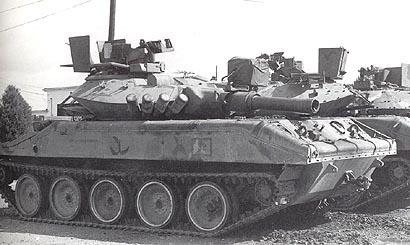 |
|
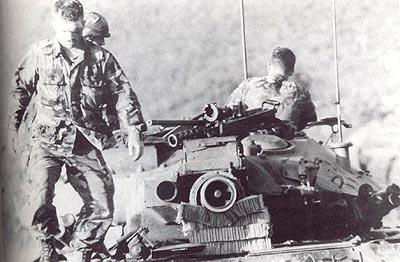 |
M551A1s
of the 4 - 68 Armor at Bragg. The last of the combat
fitted Sheridans.
|
|
Following a parachute drop, crewmen ready their
vehicle for action. Note the cardboard dunning
immediately under the main gun barrel, part of the
elaborate system to cushion the shock of landing. |
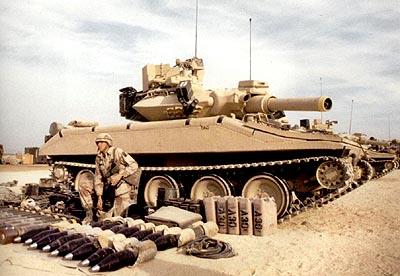 |
|
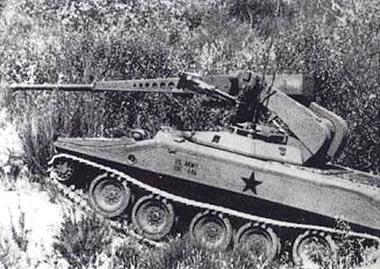 |
|
In
preparation for Desert Storm, a 3-73 Armor Sheridan
with full turret upgrade to tank thermal sight loads
up for war. Combustible case 152mm ammunition
clearly visible in foreground, missile rounds are
cased near rear sprocket |
|
Sheridan hull used with experimental articulated
high velocity cannon. |
| |
|
|
In this special contribution
to the web site, Doug Kibbey recalls his days with the Armor
Board at Fort Knox testing the laser range finder add - on for
the M551 and then visiting Fort Irwin many years later to
observe the last days of the Sheridan as the M551 VISMOD (visual
modification) program ended. Doug was also present when the
Blackhorse drew the M551s in Vietnam and is therefore in a
unique position to watch the circle close for the Eaglehorse and
the Sheridan.
Armor Board and the Laser Rangefinder
Doug Kibbey:
"As the 2/11th ACR stood down
and was withdrawn from RVN in early 1972, a couple of us had the
privilege to be assigned to the United States Army Armor and
Engineer Board (USAARENBD, the "Armor Board") at Ft. Knox where my
first duty was to join the Laser Rangefinder Project, which was
already in progress. This system was described by COL (Ret) Anker
in the previous chapter, and I can confirm one of his more
interesting observations, in particular the apparent ability to
displace birds from a perch with the laser pulse. There was
considerable training on this system, and we were monitored as
regarded the safety implications … the unknown regarding this
aspect is evidenced by the fact that those on the project had
monthly ophthalmographic photos of the retina taken to determine
if any scarring had occurred. On those days, we’d report to a base
ophthalmologist and have our eyes dilated and subjected to a
BRIGHT flash photograph of the retina that left one unsuitable for
duty for the rest of the day, so we’d try to schedule these early
for an easy day off."
"This was the first LRF system to be
employed on a production American fighting vehicle … as an
"add-on" component as was previously noted, and was essentially
the same as the integral unit first incorporated from the
beginning on the M60A2 ‘ Starship’, on which Initial Production
Test project I also served."
"The LRF project for the Sheridan
predictably involved a lot of live fire, normally conducted at
McFarland & Oliver Tank Gunnery Range well down Porter River Rd.
Additionally, the ability of the system to withstand operational
miles was tested, and included ‘X’ numbers of road miles,
unimproved (dirt) road miles, and cross-country miles between
firing sessions. Cross-country miles were accumulated unobserved
in the expanse of Carpenter Test Area, which was restricted access
in the NW quadrant of Ft. Knox beyond Cullen Maintenance Facility
and extending to the Ohio River, where we permitted ourselves a
fair amount of fun in the driving (bringing back a dry tank
commander was unofficially discouraged)."
"In the interim period prior to and during
service as OPFOR (( opposing forces )) VISMOD vehicles, the M551
was still serving operationally with the 82nd Airborne
Div. and was deployed in the conflict in Panama and to Saudi in
Desert Storm. Photos of the M551 on the streets of Panama with the
usual complement of sandbags and other accessory gear was
seriously reminiscent of Sheridans in Vietnam and I distinctly
recall a sense of déjà vu at seeing those images in the
press and on the news."
"We begin the final chapter and a lengthy
period of honorable service for the M551 that witnessed a
concurrent and then narrowed role as both operational combat
vehicle to enemy surrogate vehicle for force-on-force simulated
combat."
Force on Force Training Development, The
M551 Sheridan at Fort Irwin
"... the more you sweat in training, the
less you bleed in war"
Initially pioneered by the US Navy and
quickly adopted by the US Air Force in the early 1970s, the idea
of developing specialized squadrons schooled extensively in Soviet
air to air combat tactics was a huge step forward in the
development of highly realistic training programs. The threat
aircraft were configured whenever possible to both physically
resemble Soviet aircraft and also mimic their performance
characteristics. Each training engagement was fully tracked with
radar, video tape and audio tapes of crew transmissions to allow a
complete debriefing of the pilots on the ground at the conclusion
of the training day. At the high point of the program, the Air
Force had 4 dedicated aggressor squadrons with much of the
training focused at Nellis AFB. The US Navy maintained two
aggressor training squadrons, one in California and the second in
Virginia. The training benefit was seen as equally important in
both flying and fighting and then discussing mistakes made and
lessons learned.
The US Army was very interested in
adopting a similar program for maneuver training. As planners
turned away from Vietnam and looked to where potential
battlefields might exist beyond the plains of central Europe,
clearly, a new focus on desert warfare crystallized. Twice, the
world had held its breath, 1967 and 1973, as Israel and the
combined armies of Arab neighbors clashed. Both times, the
potential existed that the US might become directly involved in
response to Soviet aid to Egypt and Syria. Money and technology
began to come together as the National Training Center was
established at Fort Irwin California; the Army embraced a high
tech approach to both battlefield simulation and ability to both
track and then replay the battle in what became knows as the
"fight the battle - talk the battle" approach.
Key to the battalion level "force on
force" training was the use of the MILES, multiple integrated
laser engagement system, widely fielded during this period. The
system, now in a second generation form, allows weapons from the
M16 rifle through tank main gun to fire "bursts" of laser light
that mimic the ballistic characteristics of the firing weapon to
engage targets in free maneuver. Both vehicles and personnel are
fitted with sensors to register a "hit". If engaged by an
appropriate weapon, the "hit" vehicle or individual soldier is
rendered incapable of further participation in the fight until
"revived" by an umpire. The system was an enormous step forward
for the Army and remains integral to maneuver training today.
The Air Force mock up of Soviet fighters
greatly enhanced the training benefit for pilots, the Army needed
a ready platform for a similar program to make training at the NTC
as realistic as possible. Enter the Sheridan, just washed out of
the active inventory with the exception of the micro fleet at Fort
Bragg, a new mission for an old system. The Sheridans were
fitted with a variety of hull modifications to make them resemble
a vast array of Soviet weaponry, all were MILES equipped.
The National Training Center’s dedicated
training support unit, the 177th Armor Brigade was deactivated on
October 26, 1994 and then reactivated as the 11th Armored Cavalry
Regiment ( - ). The M551 VISMODs had been in active use since the
center opened in 1980.
Part 8: The New Mission, The M551 Sheridan
Reunited with the Eaglehorse
Doug Kibbey:
The following can be found as part of the
Ft. Irwin/11thCav/OPFOR online history:
"The 60th Guards Motorized Rifle Division
(GMRD), world famous as the oldest existing opposing force in the
Army on continuous active service, awaits its next victim.
The Opposing Force (OPFOR) was created to
provide a realistic, competitive and uncooperative force capable
of conducting free-play offensive and defensive operations against
the Army's Heavy Brigade Combat Teams.
The National Training Center (NTC) was
activated at Fort Irwin, California, on 16 October 1980. In June
of 1981, the 6th Battalion, 31st Infantry was formally reactivated
at Fort Irwin as a mechanized infantry battalion. This battalion
was formed from the 2d Battalion, 58th Infantry which was
deactivating. LTC Wissinger and a small cadre of his soldiers from
Fort Hood oversaw the shipment of equipment and LTC Wissinger
became the commander of the newly formed 6th battalion, 31st
Infantry. Fort Irwin was subsequently returned to active status as
an installation on 1 July 1981. These two units were activated as
Forces Command separate battalions and wore the FORSCOM patch. In
these early days there was no headquarters assigned to oversee the
operations of these battalions. The National Training Center's
Deputy Commander for Training had the "additional duty" of serving
as the commander of the OPFOR. Colonel William H. Reidl was the
OPFOR’s first commander. The last six months of 1981 were a very
busy time for the new OPFOR regiment. Some of their more notable
accomplishments included:
- Unloading, de-processing, and road
marching over 200 rail loads of both battalions' equipment.
- Conducting M551 Sheridan Transition
Training.
- Conducting Multiple Integrated Laser
Engagement System (MILES) training.
- Executing formal evaluation exercises (ARTEPs).
- Conducting Tank Gunnery for 1-73d Armor
in October.
- Completing six weeks of OPFOR training
administered by the Red Thrust Training Detachment.
- In November, both units received their
US equipment at the NTC equipment pool for use by rotational
units.
With all the required training complete by
mid-December the battalions of the regiment formed up together for
the first time in their OPFOR uniforms."
-Among the equipment mentioned in the
online history were eventually 300-330 M551 Sheridans. Over the
years, the M551 was used as an OPFOR vehicle visually modified to
serve as various models of the Boyevaya Mashina Pyekhoty (BMP),
the T-72, the 122mm SP Howitzer and the ZSU-23-4 SP anti-aircraft
platform. 1992 saw the introduction of the upgraded Sheridan
VISMODs altered to resemble the threat represented by the T-80,
and the introduction of the OPFOR Surrogate Vehicle (OSVs)
represented by the forerunner of the eventual replacement of the
Sheridan, M113 variants fitted with Bradley turrets. A number of
M551s were also stripped and painted to serve as umpire vehicles
during field exercises and with the introduction of MILES gear,
were equipped with what became known as the "god gun" which could
be used to activate the "killed" indicators for vehicles deemed to
have fallen victim to mines or other hazards. Over it’s lifetime
as a VISMOD vehicle, various materials were used to modify the
appearance, including plywood, sheet metal, fiberglass and plastic
pipes for gun extensions. High fidelity to the vehicle being
mimicked was not a priority, but at a distance the resemblance can
be quite convincing.
As might be expected, the organization,
focus, and equipment of the OPFOR at Ft. Irwin evolved steadily
over the years, and an excellent review of these topics and the
sequence of commanders is available online via Internet at the Ft.
Irwin website. Of more immediate concern here is the service
typical of units operating the M551 as a surrogate vehicle. With
the introduction/evolution of more sophisticated simulator
equipment (MILES I & II), there was a gradual loss of expertise in
tank gunnery using this platform and indeed, most of the more
recent Sheridan crews have never fired the 152mm gun/launcher.
Many of the Sheridans operating at Ft. Irwin did not have breech
assembly’s installed as they were not needed. In fact, the lack of
commonality with any other vehicle and the uniqueness of the
skills required to crew the Sheridan-based VISMODs became one of
the reasons for the conversion the OSV units, in addition to the
escalating maintenance problems and associated costs. Special
training to operate the Sheridans did not carry over usefully to
other vehicles and help maintain crew readiness for real-world
conflicts.
As the Sheridan became more dated,
maintenance problems became predictably more acute, and a credible
threat to more advanced equipment like the M1 Abrams family led to
the adoption of even some M1s as an advanced, unspecified,
potential enemy platform better represented by that vehicle.
Dubbed "Krasnovian Variant Tanks" (KVT’s) for the mythical country
that operates them, they provide some of the operational ability
lacking in the M551 VISMOD (speed, reliable stabilization, etc.)
A recent and regular participant of the
OPFOR with 1/221 Cav "Wildhorse" consulted for the preparation of
this feature shared the following insights of operations during
2003:
"It is important to think about how the
Krasnovian MIC (Mechanized Infantry Company) is organized to
understand how their "T80s" were used."
"A fully operational MIC has something
like 3 M551s (T80s) and 9 BMPs (M113s). The MIC almost always
operates with a CRP (Combat Reconnaissance Patrol) of 2 BMPs as a
screen for the main body, followed by the tank platoon and then
the APCs."
"Most MRC commanders would much rather lose two BMPs in the CRP
than their entire lead platoon when making contact with BLUFOR.
OPFOR is always seriously outranged, and outgunned by BLUFOR, and
they need the extra time to react and maneuver. The job of the CRP
is essentially to make contact, get killed and radio the BLUFOR's
grid location with their dying breath. The "T80s" are used to kill
BLUFOR tanks first, and then focus on the APCs, followed by
dismounts."
"Furthermore, the MIC cannot shoot on the move like BLUFOR can, so
more often than not when making contact, the entire MIC will stop
online and "volley" their fire with the M551s always focusing on
killing the M1s before they can be brought into the fight."
"The MILES II system allows a great deal of realism when in a
"laser fight". Not only do the hull and turrets have separate
armor values, but each side has different values as well. The M551
VISMOD does not have a laser range finder (and they would not be
allowed for use at the NTC if it did), so it is very important to
get a solid bore-sight with the MILES laser prior to any battle.
With a solid bore-sight you can hit anything between 1200 and 1800
meters center mass. Most engagements are at less than 2000
meters."
"Every M551 I have seen has always had a crew of 3 or less
(usually an E5 and two troopers). Since no loader is required with
MILES, more vehicles can be crewed with fewer men. I have at times
seen them crewed by only two. Me, I don't how they manage to fight
effectively with only a TC and a driver but they seem to do all
right."
"Probably the reason the M551 was replaced was because its engine
and transmission were so prone to breaking and we had exhausted
all of our replacement parts, and rebuilding them consumed too
much time."
That last comment is exactly right and
this observation was confirmed by officers and men at every level
during a visit in October, 2003.
The September, 1998 issue of
Soldiers-Online carried a feature on the mechanics of the NTC
and the OPFOR in particular and produced the following figures to
illuminate the requirements being made upon that specialty, and
not incidentally the load that continued use of the M551 Sheridan
was imposing:
- Average rotation: 10 days
- Annual rotations: 10
- Enlisted mechanics: 250
- Weapon systems: 2,000
- Radios: 1,200
- Generators, wheeled vehicles, etc: 2,800
- M551 Sheridan tanks: 180
- Sheridan wear and tear: 263 miles per rotation
- Engines replaced: 25-30 per rotation
- Replacement time: 8 hours per engine
- New Sheridan engine: $18,000
- Rebuilt Sheridan engine: $2,000 to $4,000
- New engine for M1 tank: $500,000
-Note that from the original figures of
between 300-330 M551s originally delivered, the numbers being
operated were down to nearly half that by 1998. As OSVs were
introduced into the inventory, Sheridans were being individually
retired. In another feature from Soldiers-Online in
November 1999, it was reported that the cost of operation of an
M551 had become double that of an OSV. During my visit to the NTC
in 2003, it was reliably reported verbally that more recently the
cost differential had risen to become more like three times that
of an OSV. Clearly the cost was becoming increasingly burdensome
and the crews operating them were not practicing the vehicle
operation skills integral to their primary training.
"Something is always broken," reported one mechanic in an article
"The
Unsung Heroes of NTC" who has been working on OPFOR
tanks for almost two years. "You have to understand that any time
these old vehicles stop, you have to start working on them or they
will break down." In most cases the OPFOR's 180 Sheridan tanks
are older than the men who drive them. "Let me put it this way,"
West explained. "I looked at the serial number on a tank I was
driving here. It was 000004 -- fourth one off the assembly line. I
bet the only Sheridan older than that is at the museum."
In the November 1999 issue of "Soldiers" this message was
echoed and the answer to the problems reported:
THE National Training Center's opposing force was in trouble.
Since its first rotation, NTC's OPFOR has portrayed the "enemy"
force by going into battle with modified M551 Sheridan armored
fighting vehicles that replicated the characteristics of tanks and
infantry fighting vehicles the Army is most likely to face in war.
The problem is that the Vietnam War-era Sheridans are getting old
and too tired to fight.
That's why the Project Manager-Training Devices (PM-TRADE),
headquartered in Orlando, Fla., developed a new OPFOR Surrogate
Vehicle and is delivering 160 OSVs to the 11th Armored Cavalry
Regiment, the NTC's OPFOR. OSV project director Scott Brookins
said the search for candidates led to several costly alternatives
before the drawdown of forces in Europe provided an economical
solution using excess M901 chassis that are part of the M113
family of vehicles.
"Using the M113 chassis, PM-TRADE developed a prototype vehicle
that resembled the Russian BMP-2, but more importantly, simulated
the BMP-2's weapons characteristics and troop-carrying
capabilities," Brookins said. The OSV made an immediate difference
within the 11th ACR.
"One of the key advantages we're seeing right now is the
reduced maintenance load," said MAJ Tim Hodge, the regiment's
force-modernization officer. "Soldiers spend a lot less time
repairing the vehicle, and it costs us about half as much per mile
to operate, counting both maintenance and fuel consumption," he
said. "So soldiers are saving time, the unit is saving money, and
we spend more time in the field."
SGT Matthew Garcia commands an E Troop OSV. His job is
navigation, supervising maintenance and making sure the mission
gets done. He's also in charge of three other vehicles, so he was
eager to trade in the M551s for the new OSVs.
"The best thing I can say about the vehicles is that they're
great for MOS - related training," he said. "Because they used
Bradley components to fabricate the turret, we're using our
Bradley skills while we're conducting a mission, and when we have
down time in the field I can train our gunners by staging mini-ARTEPs
with the other vehicles." Garcia also said that he likes the OSV
for the safety it provides his crews, especially because of the
night-vision capability, which wasn't available in the old
Sheridans.
"I have night-vision goggles and the driver has his night
sight, but now the gunner, with his thermal sight, can pick up
danger areas we might miss. I like that safety backup," he said.
"The thermal sight makes it much easier to acquire or identify
targets at night, but it also helps in daytime," said Garcia's
gunner, SPC Gregory Livingston.
"But it's the night fight where it really makes a difference.
With the Sheridans we had to use a spotlight or parachute flares
to identify and acquire targets. That would give away our position
and give the Blue Force an unrealistic advantage," he said.
"I also like the Bradley turret much better than what we had on
the Sheridan," he said. "Traversing is much quicker and you've got
stabilizers, which give you an advantage in rough terrain. You
might not be able to hit a target when you're moving fast, but
you'll be able to stay on it. And that's what matters."
It had become clear that continued use of the M551 chassis was
no longer cost effective, valuable training skills were being
wasted in the operation of an obsolete platform, and it was
beginning to affect the quality of the training available to
‘BLUFOR’ in facing a surrogate enemy with degrading technical
ability. The end was near … and inevitable. The last official OPFOR force-on-force rotations using the M551 came to an end as
2003 closed. At about the same time, there was a temporary change
in focus and training priorities at the NTC in response to a
developing operational environment overseas. In a masterpiece of
adaptation to a rapidly evolving situation, a curriculum designed
to better train units to deal with the scenario deemed COB,
"Civilians On the Battlefield" was implemented during which the
M551s were quietly parked. It was at this time that a number of
the photographs presented in the gallery were taken. In that
section will be seen VISMOD M551 "T80s" in full operational
configuration including MILES gear, vehicles partially stripped or
disassembled, and those that have been reduced to scrap. When
force-on-force training resumes at it’s regular tempo, the M551s
will not be among the OPFOR inventory, having been replaced by the
OSVs.
This marks the end of one of the longest operational histories
of any combat vehicle ever in the Army inventory.
Where are they now?
The M551 Sheridan has now been completely retired from any
official service duties with the only army in which it ever
served. A few good examples of the vehicle can still be found for
those wishing to view or research it further. These include the
outdoor display of the National Training Center at Ft. Irwin
(featured in the photo gallery); one in the Patton Museum of
Cavalry and Armor at Ft. Knox, KY; the display at the Airborne and
Special Operations Museum in Fayetteville, NC (also featured in
the gallery section) and one at the private Military Vehicle
Technology Foundation in Palo Alto, CA (special acknowledgment and
thanks to Mr. Jacques Littlefield for access to this vehicle for
the interior photos).
At least one example has recently appeared at the Latrun Museum
in Israel, having been shipped from the United States with fading
3/73rd Armor, 82nd Abn. markings.
Special thanks are due also to the officers and men of the
National Training Center, Ft. Irwin for access to the vehicles in
their service in preparation for this feature.
 |
|
Slide Show |
| |
|
|
"Lucky One"
Viewed now, the M551 program seems like an appalling collision of
designer’s good intentions, engineer’s promises and military dollars
tied to a vehicle often thrown at tasks it was never designed to
perform. Just when someone should have said "let’s wait", they said
, "let’s go". Too much money had been committed to delay the program
any further and in light of the Cold War, the line of thought often
was, an imperfect tank was better than none.
In retrospect, this was not all that uncommon in big budget weapons
systems procurement of the time. What should have been the most
basic and carefully considered equipment evolution, the fielding of
the new M16 rifle to the US military in the mid 1960s, was marked by
scandal and controversy. In the height of the Vietnam War, the rifle
powder didn’t work and the extraction - ejection sequence was
entirely too touchy. The US government bought and fielded thousands
of M16s and then set about working out the bugs. Much improved, the
basic design is still in the hands of US servicemen.
The development of US armored fighting vehicles in that early 1960s
period was certainly marked by heady ambition, innovation and
decidedly mixed results. The M114, a novel scout vehicle rising from
a blank sheet and produced by GM at the Cleveland Tank Plant, was
soon considered marginal and destined for replacement. The new M551
armored reconnaissance / airborne assault vehicle program went to
the same major defense contractor.
While the automotive problems eventually were solved, the troubled
152mm gun - launcher was always a problem and clearly a wrong turn
in US weapons thinking. It was a part of the doomed MBT 70
developmental effort and the M60A2 in its limited fielding. A
Sheridan with some variety of more conventional cannon would have
been a very interesting vehicle. By the time any serious thought
would have been given to this, however, the next generation was well
down the developmental path and M2 - M3 ended any further need for
pursuing a new light tank or extensive remanufacture of the M551.
Lasting well past the micro fleet at Fort Bragg, the long lived
Sheridan program continued at the NTC, even if only a fraction of
its former self and helped train the tens of thousands of US
servicemen who twice won decisively in the desert war they had so
long rehearsed.
What wonderful twists to the Sheridan story; early on fitted with
the Army’s first widespread laser rangefinder, the M551 lived long
at the NTC dueling with MILES laser light against visiting
battalions in the California sun. The design requirement specified
that it be able to swim, we can find no record that it ever did this
in a combat theater. The number of Sheridans destroyed in Vietnam
probably is equal to the number written off in parachute accidents
at Fort Bragg. Its combat record was built in the jungles and rice
paddies of Vietnam in a role it was never designed to play and
decades later, it was key in training a new generation of officers
and men in every nuance of desert warfare. If Waterloo was first won
on the playing fields of Eaton, then at the NTC, in the dust and
heat of the high desert, the Army learned to fulfill former Chief of
Staff Collin Powell’s statement that in part, "...we do deserts" and
a very important aspect of this was the realism in threat vehicle
array that the M551 Sheridan VISMODs provided. From Vietnam to
Germany to the United States, through the decades and across the
continents, the Sheridan is recalled by thousands of troopers, each
with their lasting memories, good and bad.
There probably are surprisingly few Sheridans left. The fleet has
already been depleted by foreign sales, REEFEX projects, the
smelters oven and the coda of down range target details. Those on
static display range from well kept monuments to sad reminders of
past glory. Built in Cleveland, they are scattered now to their
fates. The guys who assembled them are now long retired, the factory
is closed, configured as a convention center, it now features an
indoor Ferris Wheel.
At Fort Knox, along with the Patton Museum and the static display of
both US and foreign tanks, a "living museum" of running vintage
tanks is maintained. Periodically, they are taken out on a road
march for the entertainment of the crowds; the crews wear uniforms
appropriate to the period of their tank. Tankers of all ages, kids
and wives line up for the show. In the near future, as that mixed
column of Shermans and M48s snakes by, towards the end, we hope they
add a Sheridan. With so many just coming out of the inventory, it
would be a shame to not keep at least one in full running order.
In that crowd, standing roadside on a hot 4th of July, an older
veteran shepherding grand children might catch sight of this last
runner from the fleet of 1662 and, as so often an old song or half
forgotten image can suddenly transport you decades to the past in an
instant, this Sheridan would be the catalyst for a cascade of
memories. In that instant he would hold his breath and then recall
with vivid detail, all the facts, the sights and the very feel of
days so far past and then exclaim under his breath to no one in
particular, "the Ho Bo woods in 1970 ... Jimmy, Gunner and me ..."
and for another slightly younger veteran further along in the
crowd,"... so many road marches to Camp Wollbach ... and then Range
80 at Graf ..." and further along still in the crowd, an NCO at a
professional development class, "... look at that, just like at
‘planet Irwin‘ ..." as this last running Sheridan goes by.
Under all the paint and through all the years, if one could find the
first bumper number of this particular Sheridan and talk to the crew
that proudly and hesitantly took possession of the tank, as they
stripped away the manufacturer and depot pack, perhaps it had been
initially assigned to some Troop L in the regimental cavalry. On
that day, that first crew held a meeting, half joking and half
solemn, maybe in Vietnam, maybe in Germany or maybe at Fort Bliss
and discussed a gun barrel name. When they walked back to their
billet that night, in the setting sun, on the 152mm cannon barrel,
still shining as wet paint, it read "Lucky One".
Return to Hidden Stories
|
|